#herbs native to mexico
Text
Natural Healing -- Epazote
Natural Healing — Epazote

View On WordPress
0 notes
Text
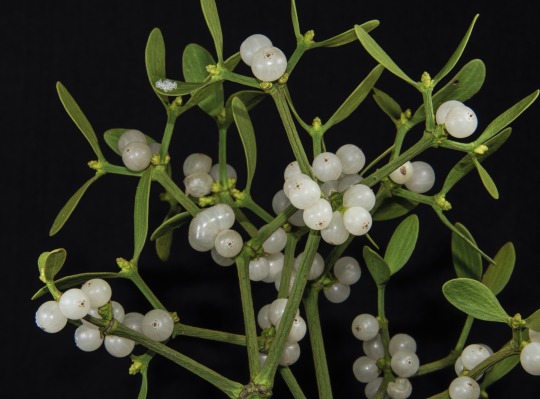
Next in the christmas botanicals series is mistletoe, the famous white-berried tree parasite associated with druids, animal sacrifice, thunder god semen, the death of the Norse god Baldr, and the Trojan hero Aeneas using it to safely travel to the underworld. Many of us may think of mistletoe as belonging solely to the British Isles and Europe, but did you know there are 1500 different species of mistletoe worldwide? There are mistletoes in the United States, Mexico, South America, Asia, and Australia too.
Mistletoe is another poisonous plant used by our pagan ancestors for spiritual protection in winter. It was brought inside homes and placed in the rafters around the winter solstice to protect from ghosts, evil spirits, witches, illness, lightning, house fires, and bad luck in general. Unlike other winter greenery, it was left up all year and only replaced at the next winter solstice or christmas day. The practice is a living tradition of paganism. It wasn’t really adopted/stolen by the church, people simply never stopped the tradition. The church never banned it. Only a handful of later Protestant ministers got upset about the newer kissing tradition in the 1800s.
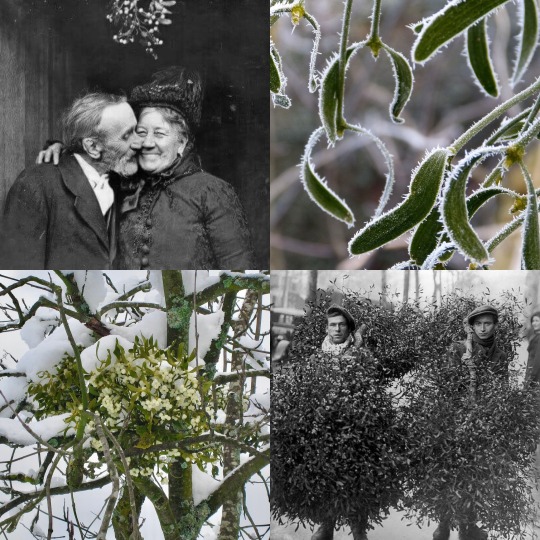
Kissing under mistletoe is believed to be Scandinavian in origin —that those who kissed under it were supposed to have a true and enduring love. This superstition ended up twisted by pervy Englishmen into a tradition of “a woman can’t refuse a kiss under the mistletoe or bad luck will befall her.” As the kissing superstition is fairly recent and largely invented —feel free to ignore it.
Mistletoe was once believed to be an antidote to all poisons and diseases. We know that’s not the case today but it does have historical traditional uses of treating arthritis, high blood pressure, respiratory issues, epilepsy, and infertility. While the plant itself has not been shown to help with cancer, some of its extracted and concentrated toxins have been found to be cytotoxic (destroys cancer cells).
Like the Native American snowberry (see previous post), mistletoe is also traditionally used to protect the cradles and beds of babies and small children. It can supposedly protect adults too when placed in the bedroom. Its presence is supposed to provide a good sleep with happy dreams.
If you have a bit of time, it’s quite a fun herb to research and maybe you’ll discover a native species growing in your region!
Resources: Wikipedia, Cunningham’s Encyclopedia of Magical Herbs, Folklore & Symbolism of Flowers, Plants and Trees, and The Folklore of Plants (Thiselton Dyer, 1889).
#bane folk#poisonous plants#poison path#mistletoe#viscum album#christmas botanicals#christmas plants#plant folklore#ethnobotany
57 notes
·
View notes
Text
Natural herbs for erection
Natural herbs for erection
Erectile dysfunction (ED) is a common condition that affects men of all ages. It is characterized by the inability to achieve or maintain an erection sufficient for sexual intercourse. There are many causes of ED, including stress, anxiety, depression, and medical conditions such as high blood pressure, diabetes, and heart disease.
There are a number of natural herbs that have been shown to be effective in treating ED. These herbs work by increasing blood flow to the penis, which is essential for an erection. Some of the most effective natural herbs for ED include:
Ginseng
Damiana
Maca
Saw palmetto
L-arginine
Muira puama
Ginseng is a traditional Chinese herb that has been used for centuries to improve sexual function. It works by increasing blood flow to the penis and by enhancing the production of testosterone.
Damiana is a shrub that is native to Mexico and Central America. It has been used for centuries as an aphrodisiac. Damiana works by increasing blood flow to the penis and by enhancing the production of dopamine, a neurotransmitter that is involved in sexual pleasure.
Maca is a root vegetable that is native to Peru. It has been used for centuries as a tonic for sexual function. Maca works by increasing testosterone levels and by enhancing the production of nitric oxide, a gas that helps to relax blood vessels and improve blood flow.
Saw palmetto is a small palm tree that is native to North America. It has been used for centuries to treat prostate problems. Saw palmetto works by blocking the conversion of testosterone to dihydrotestosterone (DHT), a hormone that can damage the prostate gland. DHT can also contribute to ED by reducing the production of nitric oxide.
L-arginine is an amino acid that is essential for the production of nitric oxide. Nitric oxide helps to relax blood vessels and improve blood flow. L-arginine can be taken as a supplement or it can be found in foods such as nuts, seeds, and legumes.
Muira puama is a tree that is native to the Amazon rainforest. It has been used for centuries as an aphrodisiac. Muira puama works by increasing blood flow to the penis and by enhancing the production of dopamine.
It is important to note that natural herbs are not a cure for ED. They can be helpful in improving erectile function, but they may not be effective for everyone. If you are experiencing ED, it is important to talk to your doctor. Your doctor can help you to determine the cause of your ED and recommend the best course of treatment.
Here are some tips for using natural herbs for ED:
Start with a small dose and gradually increase it as needed.
Take the herbs for at least 4-6 weeks to see results.
Talk to your doctor before taking any natural herbs, especially if you are taking any medications.
Here are some other things you can do to improve erectile function:
Get regular exercise.
Eat a healthy diet.
Manage stress.
Quit smoking.
Reduce alcohol intake.
21 notes
·
View notes
Text

On the Texas Border, Folk Healers Bring Modern Touches to Their Ancient Practice
Known as curanderas, they carry on a tradition long revered in local Hispanic culture.
By Edgar Sandoval
Photographs by Verónica Gabriela Cárdenas
Edgar Sandoval grew up in Mexico and the Rio Grande Valley, where Verónica Gabriela Cárdenas lives and where both covered this story.
Dec. 16, 2023
On a recent day, Chriselda Hernandez heard a knock at her door in the Texas border town of Edinburg. It was a college student who said she was suffering from a string of bad luck. A drunken driver had crashed into her car. Then someone broke into the new car she was driving and stole her laptop. “I need a limpia,” she pleaded — a spiritual cleanse.
Ms. Hernandez moved to an altar in her living room that bore an image of the Virgin of Guadalupe. Slowly, she mixed a concoction of sage and palo santo, a wood native to South America, and lit it with a match. Then she turned back to the young woman and waved the healing smoke over her body.
“You are holding on to something,” Ms. Hernandez whispered to her. “Let it go. There is no shame.”
For generations, Hispanic communities along the Southern border have turned to curanderas, or folk healers, like Ms. Hernandez, often seen in the popular imagination as old women with candles and religious icons operating in the shadows of society out of rusty shacks.
But the ancient healing art has entered the age of Instagram. More and more younger people are taking on rituals they learned from their grandmothers and deploying them against 21st century problems. They conduct limpias on public beaches, trade recipes online for blocking “envy energies” and sell artisan candles bearing the image of Our Lady of Guadalupe in shops. Their clients are often college-educated, like Clarissa Ochoa, the young woman who went to Ms. Hernandez for help.
“I think it’s an honor to be a curandera; it is something very beautiful, but also very limiting,” said Ms. Hernandez, 42. “I feel like we are breaking those boundaries, that curanderas are just herbs and little old ladies. My calling is just to heal whoever I can.”
A culture of folk healing preceded the arrival of Spaniard conquistadors to Latin America and Mexico. Over time, curanderos, a term used for healers of both genders, began mixing Indigenous rituals with elements of Catholicism and influences from Asian and African folk traditions along the way.
The practice has taken hold in Texas’ Rio Grande Valley, located a stone’s throw from the Mexican border, in large part out of necessity. Hidalgo County, home to McAllen and a majority Hispanic population, has one of the highest rates in the nation of people without health insurance, and many people rely on curanderas for lack of other affordable options, said Servando Z. Hinojosa, a professor of anthropology who teaches a class on Mexican-American folk medicine at the University of Texas Rio Grande Valley.
Mr. Hinojosa said many Hispanic residents also tend to be mistrustful of the medical establishment. This is especially true when it comes to mental health. A recent study by the Centers for Disease Control and Prevention found that while the number of Black, Asian and white people who have sought mental health care treatments has climbed in recent years, there has been very little movement among Latinos.
“There’s an element of distrust, but there is also structural alienation,” Mr. Hinojosa said. “They are a population that will seek affordable resources, and they will go to where the products are and where the advice is to be found.”
In the past, the medical establishment has warned people not to rely on folk remedies for physical ailments, some of which can be harmful. Many Latino children have fallen ill and even died after consuming such remedies known as albayalde, azarcon and rueda, powders often used for stomach-related illnesses that have been found to contain lead.
Curanderismo has become so accepted in the Rio Grande Valley that it is not unusual to see street signs and TV ads advertising folk healing services.
Ms. Hernandez said her great-grandmothers had both been parteras, or midwives. When she was a little girl, she said, she discovered that she possessed her own set of gifts; as she grew older, she said, she began interacting with an entity she believes to be the Angel of Death, Azrael. She works at a cellphone call center and lives with a girlfriend in a modern house in the suburbs of Edinburg, a city close to the border.
“You make it your own. There is no right or wrong. You do what’s right for you,” Ms. Hernandez said.
Another modern folk healer, Danielle López, 39, a former student of Mr. Hinojosa who said she also learned she had a don, a gift, as a young girl, has embraced the moniker of millennial curandera. She has combined the old traditions she learned from the grandmother who raised her, Consuelo López, and an aunt, Esperanza Rodriguez, with new skills learned at institutions of higher education.
Her academic record includes a master of arts in interdisciplinary studies with a concentration in Mexican-American literature, medical anthropology and Latin art history at the University of Texas Rio Grande Valley. She is completing a doctorate in English with a focus on borderlands literature at the University of Texas at San Antonio, where she is also a lecturer.
“For me it’s a continuity,” she said of her spiritual work. “I feel like we need it more now.”
It is not unusual for people to ask her for trabajitos, little jobs, including blessings, limpias and home remedies, when she is not buried in books. Not long ago, Ms. López got a request to bless a new business for a friend. When Ms. López cleansed the establishment with a bouquet of roses, six petals fell, prompting her to warn her friend that six people “did not have good intent.”
“They may say they are happy about her new business, but they are not.”
She also sometimes offers more science-based advice. When people tell her that they are feeling anxious or cannot sleep, she recommends that they cut their intake of sugar or caffeine. Because the advice comes from a curandera, she said, people tend to trust that she has their best interests at heart.
The concept of a curandera is so pervasive in Latino enclaves that in September the Texas Diabetes Institute, a state-of-the-art facility operated by University Health on San Antonio’s west side, a historical Mexican-American neighborhood, brought back to its lobby a sprawling wall-size painting, “La Curandera,” by the Chicano painter Jesus Treviño, who died early this year. The painting had been removed for restoration.
Still, when it comes to luck and matters of the heart, many people avoid professional help and turn to curanderas, because there is no substitute, said Sasha García, 39, a curandera who is known for her fire-red hair.
In northern Mexico, where Indigenous culture is not as widespread and the Catholic Church’s hold is stronger, Ms. García said, her ancestors often operated in the shadows to avoid the stigma associated with folk healers. By contrast, on the American side of the border, she not only feels freer to practice openly, but some Catholic priests stop by for her counsel, she said.
Ms. García welcomes clients at La Casa de la Santísima Yerberia in the city of Pharr, near McAllen, next to two imposing statues of La Santísima Muerte, skeletons each wearing red and black robes. Ms. García reminds people that while the image of La Santísima, a Latina version of the Grim Reaper, may evoke frightening emotions, death is to be revered.
“If you pray to her properly, she can heal and deliver love, freedom and wealth,” she said. “I only ask her for positive things.” (She laments that criminal elements along the border and in Mexico have appropriated the image.)
On a recent afternoon, Jocelyn Acevedo, 27, a frequent client of hers who runs a credit repair service, arrived for her monthly limpia. She had heard about Ms. García four years ago and after the first limpia, she said, she saw her business begin to boom. She was so convinced by the session that she since has regularly driven 60 miles from nearby Starr County, near the Rio Grande, for her sessions. She now has a tattoo of La Santísima.
Ms. García instructed Ms. Acevedo to rub three coconuts all over her body. Ms. García then broke them on the ground to release what she said was the negative energy her client had been carrying.
“Did it work? Of course,” Ms. Acevedo said.
Ms. García has embraced touches of modernity along with the old customs, including consultations now offered over FaceTime. Her clients have responded with their own offerings from popular culture, including a sign one brought in that now hangs on the front door: “Witch Parking Only.”
“No one listens,” Ms. García said with a smile. “The word may be becoming more modern, but we curanderas are still here. Just don’t park in my spot.”
Edgar Sandoval covers Texas for The Times, with a focus on the Latino community and the border with Mexico. He is based in San Antonio. More about Edgar Sandoval
10 notes
·
View notes
Text
Chemistry in invasive plants
Dysphania ambrosioides, known as epazote, Jesuit’s tea, or Mexican tea, is an annual or short-lived perennial herb native to Central America, South America, and southern Mexico. It is a weed often found by the roadside, the village, and the river bank. Epazote is also an invasive plant, which expands rapidly and has significant allelopathy. It will exert potent inhibition on the seed germination and seedling growth of other plants around, which will bring a serious influence on the agriculture and garden in the invaded area.
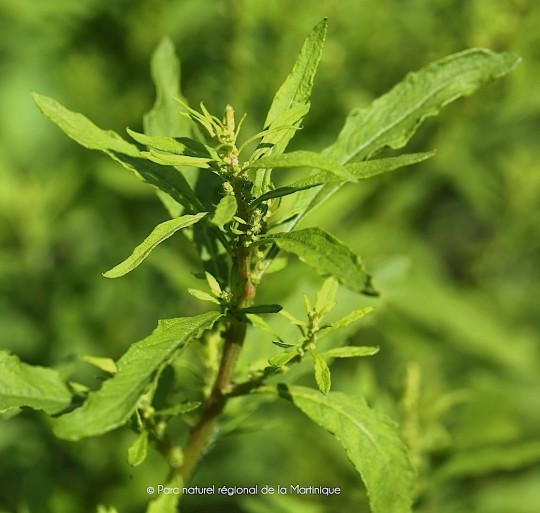
Ascaridole is the main compound in epazote, which was also the first organic peroxide found in nature. Ascaridole is repellent to insects and has some antimalarial action, but is rarely used alone due to its toxicity.

#epazotes#plant#chemistry#science#organicchemistry#compound#molecule#chemblr#factsoflife#interesting facts#didyouknow#invasive plants#invasive species
27 notes
·
View notes
Text
For @starblue2406
Here are a few things I'll eat in a day. I typically don't eat a big breakfast, but I will have a big lunch. Dinners in my family are late, usually 6pm to 8pm, we typically walk after dinner, then I'll drink tea to relax before bed.
You'll probably notice a lack of beef and pork, I have trouble digesting them, so it's mostly chicken and seafood. My family also don't eat a lot of bread, it's treated more like a side than a meal.
And yeah, there's a quite a mix of cultures here. My mom's side is Greek/Egypt with Turkish influences from her great grandfather, my dad is Native American with some adopted local New Mexico flavors. Since I was originally born and raised by the ocean, seafood and sea vegetables are a big thing in my diet. They're hard to find in the southwest, but I crave them and they keep me healthy as I have low blood pressure, so I need a bit of healthy salt.
----------------
Things I'll have for breakfast:
Apple cider vinegar mixed with honey or a fruit juice, usually pomegranate juice. Gets my digestive system prepped.
Oatmeal with dates, pumpkin seeds, and seasonal fruit.
Fresh fruit or fruit jelly with yogurt. I like Greek yogurt as it's more creamy and filling.
Seaweed soup with green onions or salmon
Kefir a type of strong yogurt drink
Crepe with fruit, pine nuts and honey
Omelet with spinach or dandelion greens
Eggs boiled in black tea and star anise
Shakshuka eggs with tomato and spices
Salmon with fried eggs
Fresh tilapia corn taco
Fruit smoothies
Green tea
Yerba mate
Lunch:
A Flatbread wrap with either chicken or falafel, lettuce, feta, red onion or tomato topped with tzatziki or Tahiti
Sardines with tomato pesto on ciabatta
Basmati rice with chicken or fish with garlic, oregano, basil
Tuna with red onion and chopped mozzarella
A salad made of lightly pickled cucumber and lato (sea grapes)
Rice soup - Made with leftover tea, seaweed, sesame seeds, fish
Baby octopus with chopped tomatoes, red onion, and oregano -
Dolma - Grape leaves stuffed with spiced rice and a meat then steamed, cabbage leaves are sometimes used instead
Ta'meya or Falafel - ground chickpeas or lentils mixed with spices and fried into rounds, topped with tzatziki or hummus
Grilled cheese with strawberry and sage
Jellyfish salad with sweet vinegar and red chili
Steamed cactus pads with watermelon rind
Blue corn bread with sweet corn
Fish cakes in a crab broth with five spice seasoning
Ful medames
Peel and eat shrimp
Mussels on ice
Shawarma
Dinner:
Grilled chicken with mixed vegetables like cherry tomatoes
Vegetable bake with seasonal vegetables
Eggplant lasagna with feta and sliced tomatoes
Cioppino - Seafood in a rich tomato broth
Risotto rice with mushroom
Shrimp with feta and tomatoes
Grilled catfish with spices
Mussels in butter and garlic
Seafood in spiced yellow rice
Crab cakes in scallop shells
Three Sisters soup - Corn, beans, squash
Spinach and cheese stuffed pastries
Squash and corn simmered in milk with pepper, garlic, and saffron
Pumpkin soup with garlic, apple, and sweet potato
Tuna steak with cranberries and feta
Zucchini stuffed with herbed rice and baked
Sayadeya - Fried fish with red onions on rice spiced with cinnamon, turmeric, and ginger
Venison chili beans
Fry bread tacos
Kushari
Chicken livers and hearts
Wild rice with elderberry and morel mushrooms
Lumpias - Like a large egg roll
Wild rice with sweet potato, pumpkin, and cranberry
Snow fungus soup with chicken bone broth
Chicken herb soup - chicken boiled with red dates, wild yam, astragalus, goji
Grilled chicken with butternut squash sweet potatoes
Mixed bean soup with chicken bone broth
Sweet and sour bitter melon soup
Between meals:
Tea with milk
Lots of different nuts
Dried fruit like dates and figs
Fresh fruit with a bit of sweet condensed milk
Jerky turkey or venison
Pickled sweet vegetables
Bruschetta with crackers
Fresh figs with goat cheese
Olives stuffed with cheese
Seaweed salad
Squid jerky
Horned melon
Naan with olive oil
Fried sardines in honey
Mushroom chips
Sweet potato chips
Crispy baby crabs
Fried sage leaves
Prosciutto
Frozen grapes
Zabladi
Cactus fruit
Quail eggs
Snap peas
Drinks:
Grape juice
Pomegranate juice
Hibiscus tea
Mint tea
Ginger tea
Anise tea
Yuzu tea
Rose petal tea
Barley tea
Flowering tea
Mountain herb tea
Water infused with fresh lemongrass and fennel
Water with basil seeds with honey
Roasted milk tea
Yerba mate
Corn silk tea
Rice milk with cinnamon and cardamom
Desserts:
Yogurt with honey and mixed fruit either frozen or seasonal
Chia pudding with peanut butter or rose petal jelly
Italian soda with sugar-free syrups of either rosewater, lavender, peach, or strawberry
Iced coffee with cacao nibs
Chocolate dipped fruit
Gelatins
Anise cookies
Amaretto biscuits
Honey comb
Baklava
Grass jelly with milk
Coconut milk pudding
Rose or pistachio halva
Sweet potato with ice cream
Snow fungus with fruit and rock sugar
Khoshaf - A dessert made of dried fruits simmered with cinnamon, nutmeg, and cloves
Lazy meals:
A typical salad
Frozen vegetables popped into a microwave and served with ready cooked shrimp or a can of sardines in tomato
Pumpkin puree in a can mixed with garlic, pepper, and milk pop into microwave
Jellyfish salad with pickled vegetables and sweet chili sauce
Thin crust pizza made from a pita with tomato, cheese, and Italian seasoning
Spinach or dandelion greens omelet with cheese
Rice soup - made with tea, fish, seaweed, and green onion
Sweet potato with toppings of choice
Baked potato with peanut butter and crab paste
Wonton wrappers stuffed with cream cheese and fried
Chestnut rice - Rice with chopped chestnuts
Chopped apples with cinnamon and honey in the microwave
Bread pudding - day old bread, fruit of choice, egg, milk pop in microwave until egg is cooked
Rice pudding - cooked rice, milk, cardamom, cinnamon, and dried chopped fruit
#What I typically eat#I love to cook so I make a lot to reheat later#Saves me a lot of prep time especially rice or beans#I'm aware some of these ingredients are off putting lol especially Jellyfish and snow fungus but they're delicious
4 notes
·
View notes
Text

Sage - Salvia officinalis
This herb is also simply called garden sage. The word “sage” has come to mean “wise” or “a wise or learned person." We're going to focus on Common Sage, the Salvia officinalis, rather than the endangered White Sage Salvia apiana.
Common Sage is originally from the Mediterranean, while White Sage is native to the southwestern United States and northwestern Mexico. Salvia comes from the Latin word salveo, “to heal” or “to save”. It has masculine energies, connects with the element of air and earth, and is ruled by the planet Jupiter. It honors Jupiter and Zeus and the Crone aspect of the Triple Goddess. Zodiac sign; Gemini.
Sage tea was used to help ease headaches, anxiety, and arthritis. People also used sage leaves as poultices on mouth ulcers or to ease sore gums. You can also make tea with sage as a gargle if you have a sore throat or to soothe the stomach if it sours. Lowers cholesterol and blood sugar levels and aids in heart health. Eases menopausal symptoms. Improves antioxidant defenses. Fights inflammation. May improve brain health, memory, and improve moods.
It is used for protection and purification spells more than anything else. But can be used for wisdom, long life, protection, health, and wishes. Sage has been utilized to ensure a long life—sometimes even immortality. This is done by eating some of the plant every day, or at least in May, for: "He who would live for aye, Must eat sage in May."
Sage is carried to promote wisdom, and the leaves are used in countless healing and money spells.
To guard yourself against contracting the evil eye, carry it in a sachet.
To make a wish come true, write it on a sage leaf and hide it beneath your pillow. For three nights sleep upon it. If once you dream of what you desire, your wish will be materialized; if not, bury the sage in the ground.
#witchy herbs#sage#garden sage#protection#purification#witchy#witchcraft#witchblr#witchy vibes#witch aesthetic#witchythings#pagan
10 notes
·
View notes
Text
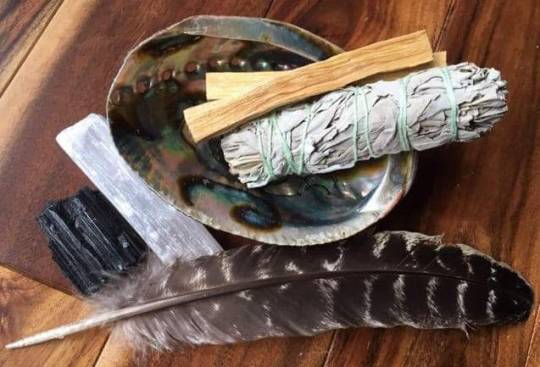



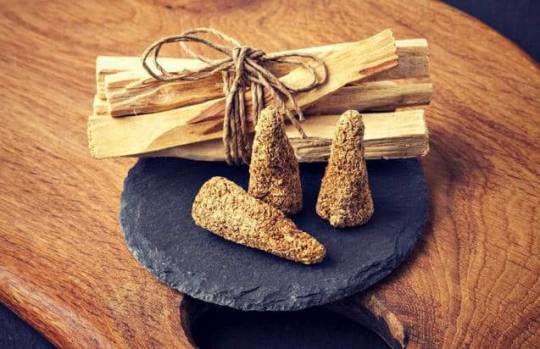


Palo Santo Vs Sage: Which one is best for smoke cleansings
The practice of burning herbs, resin, and wood for cleansing purposes have been used by cultures all around the world. The earliest recordings of palo santo use date back to the ancient Inca people. Sage is more commonly associated with Native Americans but also has roots with Celtic Druids.
With deep roots like these, there’s obviously more to these cleansing tools than fanciful thinking.
how sustainable they are, and which one is the most beneficial.
Most sage is harvested from the Southwest of the US and some parts of Northern Mexico. This desert dwelling shrub loves the hot dry climate. Palo Santo comes from South America, and grows along the coastline of Peru.
Sage has a very strong, herby scent that’s not for everyone! Don’t get me wrong I love sage, but when I discovered palo santo I was sold on the scent. Palo santo has a sweet, subtle and fresh smell with hints of mint and citrus.
Both of these healing tools are over-harvested and endangered. It’s important to research where you’re buying your sage and your palo santo from to ensure you’re not adding to the over harvesting and endangerment of these gifts from Mother Earth , Buy from local sellers OR buy from places that buy either local, OR grow their own. It never hurts to ask where a place gets their sage from!!There are companies that sell sustainably sourced sage and palo santo. The cost might be a little higher, but you can rest easier knowing you’re supporting companies that are harvesting these priceless plants in a sustainable way.
6 notes
·
View notes
Text
Herbal Glossary!
A
Anise Hyssop
Origin: The name comes from the Greek word hyssopos and the Hebrew word for Azob, a holy herb used for cleaning sacred places. Hyssop is native to southern Europe and the Mediterranean.
Benefits: Create a delicious tea to help relieve symptoms of the common cold, such as congestion.
Arnica
Origin: Arnica has been used for its many healing properties for centuries, since its discovery by goat herders who noticed their goats went up the mountains in search of its flowers to heal themselves after falling or stumbling.
Benefits: Arnica can help reduce bruising and swelling, as well as muscle soreness from exercise or sports injuries.
Ashwagandha
Origin: In Ayurvedic healing tradition, ashwagandha is recognized as one of the most powerful herbs. Use of this root can be traced back for over 3,000 years.
Benefits: This is an adaptogenic herb that can be used to strengthen your immune system and to target the negative effects that stress takes on the body.
Astragalus
Origin: Astragalus is a foundational herb in Traditional Chinese Medicine to support one’s Chi.
Benefits: Use astragalus to support a weakened immune system.
B
Blue Lotus
Origin: Blue Lotus was prized above all other plants by the Ancient Egyptians. The plant was associated with the Sun God Ra as the bringer of light.
Benefits: Use Blue Lotus to calm the nerves and brighten your mood.
C
Calendula
Origin: Calendula has been considered a magical herb for centuries. Ancient Egyptians used it for their skin, the Greeks and Romans used it as a culinary herb, and in ancient and modern India it is used in wedding ceremonies.
Benefits: Use Calendula to support healthy skin, cure stomach ailments, and in culinary dishes.
California Poppy
Origin: The early Spanish settlers of California saw the California Poppy lighting up the coastal hillsides, and it is said they could guide their ships by the sight.
Benefits: Use California Poppy as a tincture for mild sedative and analgesic effects and also as an anxiolytic (anti-anxiety remedy). California Poppy contains no opiates, and is non-addictive and safe.
Chaga
Origin: Chaga has been recognized for thousands of years as a powerful healing mushroom. Ancient Asian Folk Medicine practitioners relied on it for balance, and to boost the immune system. Chaga also has a long history of use in Russian and Siberian folklore and herbalism.
Benefits: Use it in a tea to boost immunity, energy, and reduce inflammation.
Chlorella
Origin: Known as the “Jewel of the East”, chlorella is a genus of single cell freshwater green algae which is comprised of organisms that have survived as a life form for billions of years.
Benefits: Use chlorella to detoxify, support your immune system, and aid in digestion.
Cordyceps
Origin: According to legend, yak herders in the Himalayas of Tibet and Nepal noticed that their yaks grazed on a certain mushroom, they suddenly become very energetic and playful.
Benefits: Use Cordyceps in a tincture or powder to increase energy, detoxify the body, stimulate the immune system, and as an overall tonic for the body.
D
Damiana
Origin: Damiana has been used since the times of the Aztecs in Mexico, Central America, and South America. Originally taken during religious ceremonies, it was later banned due to its "passion inspiring properties."
Benefits: Damiana helps to boost libido and is known as an essential aphrodisiac.
Dandelion
Origin: Dandelion's common name was apparently invented by a 15th century surgeon, who compared the shape of the leaves to a lion's tooth, or dens lionis.
Benefits: Both the Dandelion leaf and root have been used for centuries in traditional medicine to treat liver, gallbladder, kidney ailments, weak digestion and rheumatism.
E
Echinacea
Origin: Echinacea was the primary medicine of the North American Indians, who used root poultices for wounds, bites, stings, and snakebites.
Benefits: Use Echinacea as soon as you feel a cold coming on for powerful immune support.
Elderberry
Origin: “Father of medicine” Hippocrates recognized elderberry’s gifts as early as 400 AD. Elderberry was often called the “medicine chest” of the country folk.
Benefits: Elderberry is often used for its ability to boost and balance the immune system and quell coughs, colds, flu, and bacterial and viral infections. Make your own syrup or take as a tincture.
Elecampane
Origin: Elecampane is reputed to owe its genus name "Inula Helenium", to the fabled beauty Helen of Troy.
Benefits: Elecampane is wonderful for respiratory health, for digestive health, and can be used as an anti-parasitic.
F
Fennel
Origin: Fennel crops up in Greek mythology, when humanity received a fiery coal from Mount Olympus in a fennel bulb. Hippocrates talked about the medicinal powers of fennel to treat infant colic.
Benefits: Fennel Seeds help to relax the smooth muscles of the digestive system, which stimulates bile flow and reduces pain associated with digestion.
G
Ginger
Origin: In Ayuverdic medicine, ginger is called the “universal medicine.” In Chinese Medicine for over 4,000 years, Ginger was used to treat nausea, dysentery and to act as an overall digestive stimulant.
Benefits: Use ginger to soothe an upset stomach, a cold, or a case of the flu. Take in tincture form, cook in its dried or fresh form, or brew as a tea.
Gotu Kola
Origin: Gotu Kola is an Ayurvedic herb that was first used in India where it has a reputation for rejuvenating the body and mind. Gotu kola is said to also develop the crown chakra.
Benefits: Use this herb in a tea to enhance concentration and memory.
H
Hawthorn Berry
Origin: Hawthorn is a symbol of love and union. The Hawthorn tree is steeped in Celtic mythology and history, with many believing that the trees were inhabited by the Faery Folk.
Benefits: Use Hawthorn Berry in a tincture or tonic for heart health and improved circulation.
I
J
Jasmine
Origin: The name “Jasmine” derives from the Persian word Yasmin, meaning "Gift from God.” The flower is sacred in India and the Himalayas.
Benefits: Use Jasmine’s uplifting scent to help boost mood. Jasmine is wonderful as a tea or infused in oil.
L
Lavender
Origin: Lavender is probably the most well known medicinal herb. Originally from France and the western Mediterranean, lavender is now cultivated worldwide.
Benefits: Lavender can be used as a sleep-aid, to help heal wounds and burns, and to quell anxiety.
Learn More
Lemon Balm
Origin: Also known as “Sweet Mary,” “Honey Plant,” and “Cure-All,” this herb has been cultivated as a culinary and medicinal plant for over 2,000 years.
Benefits: Use Lemon Balm to combat anxiety, treat wounds, and soothe indigestion.
Linden
Origin: Linden is included in the folk stories and mythology of many different European cultures. In the symbolism of flowers, linden is a symbol of conjugal love, sweetness, peace and happiness.
Benefits: Linden flowers have been used traditionally for colds, cough, fever, infections, inflammation, high blood pressure, and headache.
Lion's Mane
Origin: Lion’s Mane has been a staple in Traditional Chinese Medicine for centuries. It’s also known as “deer’s tail,” “satyr’s beard,” and even the “pom pom” mushroom.
Benefits: This mushroom has adaptogenic properties and may protect against dementia, reduce mild symptoms of anxiety and depression and help repair nerve damage.
M
Maca
Origin: Maca was first utilized by the Incas in Peru. Maca root grows in the mountains of Peru at high altitudes of 7,000 to 11,000 feet, making it the highest altitude growing plant in the world.
Benefits: Use Maca as a mood and libido booster, or a hormone stabilizer. Add in powder form to coffee, teas, or smoothies.
Marshmallow
Origin: Stems of marshmallow were originally peeled to reveal the soft and spongy pith. This pith was boiled in sugar syrup and dried to produced a soft, chewy confection.
Benefits: As a demulcent it is an agent that forms a soothing film over mucous membranes, relieving minor pain and inflammation of the membrane.
Matcha
Origin: Matcha can be traced back to the Tang Dynasty in China, where citizens would steam tea leaves into bricks, making it easier to transport and trade.
Benefits: Matcha is great for boosting the metabolism and is a wonderful alternative to coffee. It is filled with antioxidants and is rich in fiber.
Mimosa Flower
Origin: Mimosa has been called “the happiness flower” and is used in Traditional Chinese Medicine to cleanse the heart and liver meridians (energetic pathways) in the body. Mimosa tree bark is also used as a common remedy for generalized muscular discomfort and swelling.
Benefits: Use Mimosa Flower for emotional relief, especially from grief or anxiety.
Mucuna Pruriens
Origin: Mucuna Pruriens is classified in Traditional Chinese Medicine as a jing enhancing herb. Jing loosely translates as “life force” or “vital essence."
Benefits: Mucuna Pruriens can be used to increase libido, support brain health, and boost mood. Drink as a tonic or in put in smoothies, teas, and coffee.
Mugwort
Origin: Around 1,000 years ago, medieval brewers used Mugwort to make a beer or ale called "gruit.” Mugwort is called the “Mother’s Herb” and is traditionally used for dreamwork.
Benefits: Use this herb to aid in lucid dreaming, help regulate periods, and alleviate joint pain.
N
Nutmeg
Origin: Nutmeg has a long history of use as a spice, with recorded evidence that the ancient Romans and Greeks enjoyed its warm, aromatic flavor and aroma.
Benefits: Use nutmeg to relieve pain, soothe indigestion, relieve insomnia, and improve brain function. Nutmeg can also help protect the liver, improve cholesterol levels, and regulate blood levels.
O
Oat Straw
Origin: Archaeological studies show that oats have been found dating from 2,000 BCE and have been used ever since as a valuable source of human and animal nutrition.
Benefits: Uses include helping to balance the menstrual cycle, to treat dysmenorrhoea, for osteoporosis and urinary tract infections. Drink in an herbal infusion for maximum benefits!
P
Peppermint
Origin: Peppermint was used in ancient Roman, Greek, and Egyptian cultures in both culinary and medicinal forms.
Benefits: Use Peppermint as a digestive aid to soothe stomach pains and indigestion.
R
Red Clover
Origin: Red clover has been used for 400 years in anti-cancer formulas.
Benefits: Because of red clover’s concentration of the phytoestrogens daidzein and genistein, which mimic the activity of estrogen, red clover has been studied for its use in alleviating the discomfort of menopause.
Reishi
Origin: The Reishi Mushroom is one of the most valued plants in traditional Chinese medicine, and is described alongside Ginseng as one of the two most important elixirs.
Benefits: Use Reishi for an immune system boost, improved liver function, and to restore hormonal balance.
Rose
Origin: The Greeks, Persians, and Romans all used roses as medicine. The botanical name of the Wild Rose, rosaceae canina reflects how the Romans used it to help treat rabid dog bites.
Benefits: Roses have astringent, anti-viral, anti-bacterial, and diuretic properties.
Rosemary
Origin: Usage of rosemary dates back to 500 b.c. The ancient Greeks and Romans used it as a culinary and medicinal herb.
Benefits: Rosemary can be used for improved concentration and improved digestion. It may help alleviate muscle pain, boost the immune and circulatory system, and promote hair growth.
S
Saffron
Origin: Traditional healers have historically used saffron to treat heartache, hemorrhoids, and other kinds of inflammation. Cleopatra was said to bathe in saffron-infused mare’s milk before seeing a suitor.
Benefits: Saffron can be used as an aphrodisiac, asthma, dry skin, heartburn, and for baldness.
Sage
Origin: In ancient Rome, the herb was used to heal ulcers, stop the bleeding of wounds, and to soothe a sore throat. The Chinese used sage to treat colds, joint pain, typhoid fever, and kidney and liver issues.
Benefits: Sage is known to lower cholesterol, and is a tonic for the liver. Sage is helpful for women’s health, specifically pain from menstruation.
Schisandra
Origin: Chinese folklore and Traditional Chinese Medicine says that Schisandra can "calm the heart and quiet the spirit.”
Benefits: Add Schisandra to your home apothecary for a powerful anti-anxiety tool.
Shilajit
Origin: Shilajit has been known and used for centuries in Ayurvedic medicine as a rejuvenator and anti-aging compound.
Benefits: Shilajit is useful in the treatment of kidney stones, edema, and hemorrhoids, and as an internal antiseptic.
Spice Bush
Origin: Native Americans originally used the bark, twigs and berries to make teas that could help treat colds, fevers and rheumatism.
Benefits: Make a warming and stimulating tea from spice bush to help with both digestion and circulation.
Stinging Nettle
Origin: Stinging nettle, or Urtica dioica, is a flowering plant that is found worldwide. It is native to northern Africa, North America, Asia, and Europe.
Benefits: Use Stinging Nettle in a tea to reduce inflammation, help with hay fever, and aid in stabilizing blood sugar levels.
T
Thyme
Origin: Thyme’s name is from the Greek word thymos, meaning “strong.”
Benefits: Thyme can be used as a nervine herb (to relieve stress) or to help heal respiratory infections. It can also improve digestion and has antibacterial properties.
Tremella
Origin: Tremella comes to us from Traditional Chinese Medicine for overall immune health.
Benefits: Use it to help aching joints or muscles, or for complexion and skin health.
Tulsi
Origin: Tulsi or ‘Holy Basil” comes from the healing tradition of Ayurvedic medicine.
Benefits: In herbalism, Tulsi is considered to be an adaptogen. Adaptogens can help your body adapt to stress and restore balance. Tulsi is especially good for pain relief, digestive support, and respiratory health.
Turmeric
Origin: Turmeric has been used in ancient Ayurvedic medicine as a cleansing herb.
Benefits: Turmeric can aid in reducing overall inflammation and improve digestion. Cook with tumeric, make into a tonic, or take as a tincture!
U
V
Valerian
Origin: Valerian has been used as a medicinal herb since at least the time of ancient Greece and Rome.
Benefits: Valerian can be used to ease insomnia and anxiety, reduce pain, and as a muscle relaxant.
W
Witch Hazel
Origin: Native Americans have long used the twigs and bark of witch hazel as a medicinal herb for a wide variety of ailments.
Benefits: Brew it in a tea to treat a sore throat or common cold.
Wood Betony
Origin: The name Betony comes from Celtic where Bew meant “head” and Ton meant “good.”
Benefits: Wood Betony was originally used by both Native Americans and Europeans for its medicinal and aphrodisiac qualities. Use it for headache relief, or as an aphrodisiac.
X
Y
Yerba Santa
Origin: It was given its name, “holy weed,” by Spanish priests impressed with its properties.
Benefits: Yerba Santa is used for respiratory conditions including coughs, colds, tuberculosis, asthma, and chronic bronchitis
To learn more, check out this link that I borrowed this info from:
Or check these out, link is below:
ACACIA POWDER - GUM ARABIC
Treats respiratory illness and diarrhea; magical uses: Protection, psychic and spiritual enhancement, money, platonic love, and friendship.
ACTIVATED CHARCOAL - COCONUT SHELL
Emergency toxin removal; teeth whitening; aids kidney health; treats diarrhea and skin infection
ALFALFA POWDER - MEDICAGO SATIVA
Revitalizes digestive tract and colon. Decreases irritability and nervousness. Combine with peppermint to make a tonic for the stomach; magical uses: Money, prosperity, anti-hunger
ALKANET - ALKANNA TINCTORIA
Provides natural red tint to cosmetics, heals wounds; magical uses: Purification, prosperity. Protects from snakebites and helps ease fear of snakes
ALLSPICE - PIMENTA DIOICA
Digestive aid; anti-inflammatory and pain reliever; Immune booster; promotes oral health; Magical: Money, luck, healing, obtaining treasure.
ALOE
Used as far back as Ancient Egypt, Aloe Vera heals wounds and relieves sunburn. Part of Cleopatra's daily beauty routine, aloe can be beneficial to many skin issues including psoriasis and acne. It has anti-inflammatory properties can also be topically applied for relief from aching joints and tendonitis. Magical uses: Protection and luck.
ANISE SEEDS (PIMPINELLA ANISUM)
calms and builds the nervous system; natural remedy for gas, bloating, cramping, and digestive issues; breaks down mucus- good for bronchitis and asthma; pain-relieving (especially coughs, GI issues, and menstrual cramps). Emotionally good for nervousness and insomnia; Magical uses: Used to help ward off the evil eye, find happiness, and stimulate psychic ability.
ANISE STAR PODS - WHOLE - ILLICIUM VERUM
Decongestant and expectorant
ANNATTO SEED (GROUND) - BIXA ORELLANA
Treats diabetes, diarrhea, fevers, and fluid retention. Use topically for burns and vaginal infections.
ARROWROOT POWDER
Contains potassium, iron, and vitamin B; promotes heart health and boosts immunity; treats toothaches and gum soreness (give babies arrowroot cookies for teething); magical uses: Purification and healing
ASHWAGANDHA ROOT
Ashwagandha is an adaptogenic herb from India that is used for supporting endocrine function, immune function, brain function, whole-body revitalization and emotional balance. This tonic herb is widely used for stress relief, hormone balance, supporting mental health, aiding restful sleep and imparting a sense of holistic wellbeing. Whether you are anxious or fatigued, ashwagandha supports balance and can aid the body, mind and spirit in returning to equilibrium and vitality.
ASTRAGALUS ROOT - POWDER - A. MEMBRANACEUS
Astragalus is a prized adaptogenic herb in Traditional Chinese Medicine, lauded for its whole-body rejuvenative and protective properties. It is used as a longevity tonic and to strengthen and protect metabolism, digestion, immunity, energy levels, skin health and whole-body health.
ASTRAGALUS ROOT - SLICES - A. MEMBRANACEUS
Magical uses: Protection and energy
BASIL LEAF - OCIMUM BASILICUM
Named after the Basilisk, Ancient Greek lore claimed that this herb could cure the creature's petrifying stare and used it to treat snake bites and insect stings. Also traditionally used to detoxify from cannabis in India and the Middle East, Basil can detoxify from drugs that store themselves in fat cells. Can increase sex drive and promote menses. Magical Uses: Love, exorcism, wealth, sympathy, and protection. Dispels confusion, fears & weakness.
BAY LEAF - LAURUS NOBILIS
Contain vitamins A & C, iron, calcium, potassium, and magnesium; include in food regularly to promote general health; tea is good for migraines (infuse 3 leaves and juice of 1 lemon in hot water); Magical Uses: Protection, good fortune, success, purification, strength, healing and psychic powers. Also, the herb of poets and the god Apollo (Sun).
BEET ROOT POWDER - BETA VULAGRIS
Builds the blood and cleanses the liver. High glucose content. Magical uses: Love Spells
BLACK PEPPERCORN - PIPER NIGRUM
reduces inflammation; full of vitamins and minerals; helps with nutrient retention; Banishing negativity, exorcism, and protection from evil.
BLACKBERRY LEAF
helps with diarrhea, sore throat, and ulcers; wards off evil spirits; Magical Uses: Healing, protection and money
BLOODROOT - POWDER - SANGUINARIA CANADENSIS
Expectorant; Fights bacteria and inflammation
BLUE COHOSH ROOT
rheumatism; American Indian female remedy: cramps, back pain, menopause, amenorrhea; used for nerves and spinal injury; depression and brooding; Magical uses: Empowerment, purification, money drawing, love breaking, and driving away evil.
BORAX POWDER - NATURALLY SOURCED
Cleaning agent and natural pesticide
CACAO BEANS - THEOBROMA CACAO - ROASTED
Cacao is renowned for its anti-inflammatory, nervous system boosting, and stress reducing effects. It's consumption can promote feelings of wellbeing and bliss. The scientific name means "food of the gods", after all!
CACAO POWDER - ROASTED, FAIR TRADE
Cacao is renowned for its anti-inflammatory, nervous system boosting, and stress reducing effects. It's consumption can promote feelings of wellbeing and bliss. The scientific name means "food of the gods", after all!
CALAMUS ROOT - POWDER - ACORUS CALAMUS
Used by Native Americans as "the Singer's Herb" calamus primarily targets the trachea. Good for laryngitis, halitosis, sinus congestion, asthma, and chronic cough. Magical Uses: Luck, money, healing, and protection
CALENDULA FLOWERS - CALENDULA OFFICINALIS
The beautiful, sunny calendula flower contains potent anti-inflammatory and anti-viral properties and has a variety of uses. Calendula can be used to speed healing of wounds and skin irritations and also as a tea for a variety of health benefits. Magical Uses: Protection, legal matters, and psychic/spiritual powers
CARAWAY SEED - CARUM CARVI
Historically known to prevent things, lovers, and pigeons from straying. Caraway is one of the "four greater hot seeds" of Greek medicine used to stimulate digestion (along with fennel, anise, and cumin). Magical Uses: Health, love, protection, mental powers, memory, passion, and anti-theft. Fidelity in love spells.
CARDAMOM PODS - ELETTARIA CARDAMOMUM
Clears the mind; treats coughs, colds, and asthma; treats bloating. gas, and indigestion; treats sickness from damp, hot weather; Magical Uses:Lust, love, and fidelity
CAROB, ROASTED - CERATONIA SILIQUA
"the singer's herb", cleanses the throat, good for weight loss and stomach settling; Magical Uses: Health and protection
CASSIA CINNAMON - CHIPS - CINNAMOMUM SP.
Anti-diarrheal, treats nausea, abdominal cramping, and gas; helps with menstrual and postpartum issues; staunches bleeding; Magical Uses: Spirituality, success, healing, protection, power, love, luck, strength, and prosperity.
CATNIP - NEPETA CATARIA
fever reducer; calming; promotes sleep and digestion; helps with morning sickness; makes cats happy and spunky; Magical uses: Sacred to Bast; should be used in any ritual involving cats or cat deities. Use with rose petals in love sachets. Use in sachets and spells designed to enhance beauty or happiness. Provides protection while sleeping.
CEDAR LEAF - THUJA PLICATA
Strong disinfectant; expectorant; treats fungal skin conditions like athlete's foot and ringworm; Magical uses: Confidence, strength, power, money, protection, healing and purification. Used in the consecration of magick wands.
CELERY SEED - APIUM GRAVEOLENS
cooling and sedative diuretic; aids kidney function; helps with arthritis, aches, and pains; Magical Uses: Mental and psychic powers, concentration.
CHAMOMILE - POWDER - MATRICARIA RECUTITA
Chamomile flowers are powerfully healing, immune boosting and anti-inflammatory. Chamomile is often used in tea for its calming effects. It can also protect skin, lower stress and soothe menstrual cramps.
CHAMOMILE FLOWERS - WHOLE - MATRICARIA CHAMOMILLA
Chamomile flowers are powerfully healing, immune boosting and anti-inflammatory. Chamomile is often used in tea for its calming effects. It can also protect skin, lower stress and soothe menstrual cramps. Magical Uses: Love, healing, and reducing stress.
CHIA SEED - SALVIA HISPANICA
High in antioxidants, fiber, omega-3 fatty acids, and protein; promote cardiovascular health; Magical Uses: Protection and health.
CHILI WHOLE - CAPSICUM ANNUUM
Magical Uses: Fidelity, love, and hex breaking.
CHILI, RED ROASTED - POWDER - CAPSICUM ANNUUM
May help to promote weight loss and relieve pain
CHLORELLA POWDER
Considered a superfood due to its nutrient content; aids in detox
CILANTRO - CORIANDRUM SATIVUM
natural food preservative; increases energy; weight loss; anti-inflammatory and anti-fungal; promotes skin health; Magical Uses: Protection of gardeners; brings peace to the home and helps to attune one with their soul. Magical Uses: Draws friends to the home, customers to the business. Promotes eloquence, persuasiveness, and prosperity. Protects and cleanses the aura. Encourages self-expression and creativity
CINNAMON - CINNAMOMUM BURMANNII - POWDER
Anti-diarrheal, treats nausea, abdominal cramping, and gas; helps with menstrual and postpartum issues; staunches bleeding
CINNAMON STICK - CINNAMOMUM BURMANNII - POWDER
Anti-diarrheal, treats nausea, abdominal cramping, and gas; helps with menstrual and postpartum issues; staunches bleeding
CLOVE POWDER
In small doses, heightens senses and is considered an aphrodisiac. In moderate doses, can be used as a sleep aid and pain killer. Good for toothaches, earaches, indigestion, morning sickness, and impotence. Magical Uses: protection, banishing hostile/negative forces, and gaining what is sought
CLOVES WHOLE
In small doses, heightens senses and is considered an aphrodisiac. In moderate doses, can be used as a sleep aid and pain killer. Good for tooth aches, earaches, indigestion, morning sickness, and impotence. Magical Uses: protection, banishing hostile/negative forces, and gaining what is sought
COCONUT FLAKE - DRIED, UNSWEETENED
High in fiber; raises good cholesterol
COMFREY - SYMPHYTUM OFFICINALE
Contains allantoin which causes cell growth, leading to its remarkable healing properties. Heals wounds and draws out toxins. It has long been used to heal broken bones. Magical Uses: money, safety during travel, and any Saturnian purpose. Use for workings involving stability, endurance, and matters relating to real estate or property.
CORDYCEPS MUSHROOM POWDER
Boosts energy levels and stamina; anti-inflammatory; adaptogenic; anti-aging; performance enhancing; immune boosting
CORIANDER SEED - CORIANDRUM SATIVUM
treats chronic indigestion, bloating, gas, or cramps; Magical Uses: Love, health, immortality, and protection.
DAMIANA - TURNERA DIFFUSA
Aphrodisiac; relieves stress and tension; antidepressant; promotes digestive health; Magical Uses: Lust, sex magick and attracting love.
DANDELION ROOT - TARAXACUM OFFICINALE
Fever reducer; cleanses the liver, gallbladder, and pancreas; use for chronic inflammatory conditions, PMS, and Menopause; sleep aid
DILL WEED - ANETHUM GRAVEOLENS
Treats colic and gas, especially in children; stimulates lactation
DONG QUAI
allergies, headache, congestion; known as the "Empress of Herbs" for it's ability to regulate the menstrual cycle and menopause; aids bone generation (osteoporosis);
DULSE - PALMARIA PALMATA
Promote thyroid and bone health; good source of calcium and potassium; can lower blood pressure and strengthen eyesight; Magical Uses: Lust, harmony in the home, sea rituals and pacifying sea winds.
ECHINACEA AUGUSTIFOLIA
helps reduce cold and flu symptoms, indigestion, dizziness, migraines, UTIs, yeast infections, and fatigue; Magical Uses: Adds powerful strength to charms, sachets, and herb mixes.
ELDER FLOWERS - SAMBUCUS NIGRA, ELDERBERRY, POWDER - SAMBUCUS NIGRA, ELDERBERRIES - WHOLE - SAMBUCUS NIGRA
The Elder tree was called the "Elder Mother", Queen of the Underworld or Faery. Since faeries kidnap human souls, sleeping under the elder or using it's wood to make cradles was deemed perilous. The tree was also associated with the god Pan, the Lord of the Underworld, whose pipes were made from its hollow stems. Elder is one of the primal remedies of European tradition and was widely planted to be used as a "medicine cabinet". Used to treat the flu, colds, and respiratory infections; also used to make a syrup that boosts immune system in winter; "the great infant remedy"- used for croup, respiratory issues; treats anemia and menstruation problems like fibroids; Magical Uses: Sleep, releasing enchantments, protection against negativity, wisdom, house blessing and business blessing. Used in rites of death & dying to protect the loved one during transport to the Otherworld.
EUCALYPTUS - EUCALYPTUS NITENS
Expectorant and antiseptic; used in sinusitis, bronchitis, asthma, pulmonary infection and congestion. Magical Uses: Attracts healing vibrations, great for protection and healing sachets. Use to purify any space.
FRANKINCENSE POWDER - BOSWELLIA CARTERI
Immune boosting, anti-depressant, good for asthma and coughing fits; oil good for skin issues and oral health; Magical Uses: Successful ventures, cleansing, purification. Burn for protective work, consecration, and meditation. Used as an offering at Beltane, Lammas, and Yule.
GALANGAL ROOT POWDER - ALPINIA OFFICINARUM
Used to treat indigestion, dyspepsia, and hemorrhoids. Said to be a cross between ginger and cayenne. Magical Uses: Magickal uses include winning in court, doubling money, hex breaking and sex magick.
GARLIC GRANULES - ALLIUM SATIVUM
One of the most ancient medicines in the world. Antimicrobial and detoxifying, garlic kills foreign bacteria and improves digestion. Stimulates metabolism. Good for cardiac and digestive health. Also known to help nervousness, anxiety, insomnia, and weight loss. Magical Uses: healing, protection, exorcism, repulsion of vampires, and purification of spaces and objects. Used to invoke Hecate.
GINGER ROOT - ZINGIBER OFFICINALE
Fever reducer, treats cold or flu; reduces nausea from motion sickness, pregnancy, etc.; improves digestive health; expectorant; blood thinner, increases circulation; SPECIFIC for labor and delivery, connects mother and child in the womb, the tea unites everyone in the room in the spirit of delivery, keeps up strength in long labors (add honey to make blood sugar available); Mix freshly grated ginger with wine and let sit overnight, use result topically for acne or eye inflammation; Magical Uses: Draws adventure and new experiences. Promotes sensuality, sexuality, personal confidence, prosperity, and success.
GINGKO BILOBA - FALL GOLD - GINKGO BILOBA
Treats asthma and upper respiratory disorders; symbolizes longevity and enlightenment; improves circulation and cognitive function; Magical Uses: Aphrodisiac, associated with fertility.
HEATHER FLOWERS - CALLUNA VULGARIS
Add to a bath for toning muscles and soothing rheumatic pain; antiseptic; diuretic; Good for nervous and menstrual issues; may open portals into the faery realm; Magical Uses: Protection, luck, and immortality.
HELICHRYSUM FLOWERS - WHOLE - HELICHRYSUM ARENARIUM
diuretic, anti-inflammatory, and antiviral; aids in digestion; treats rheumatism; helps with cystitis and lethargy from PMS
HIBISCUS - HIBISCUS SABDARIFFA
anti-oxidant, high in Vitamin C, used to treat cold and flu; aids menstruation; symbol of the goddess Kali; Magical Uses: Attracting love and lust, divination, and dreams.
HOLY BASIL (TULSI), KRISHNA - OCIMUM TENUIFLORUM
adaptogen; good for arthritis or fibromyalgia; relieves stress, anxiety, and inflammation
HOPS, FLOWERS - WHOLE - HUMULUS LUPULUS
treats diarrhea, constipation, bloating, headaches, weight loss; good for healthy skin, anxiety, and sleeplessness; historically, Hops pillows were used to treat insomnia for both King George III and Abraham Lincoln; often used for male reproductive health and urinary issues; Magical uses: increase the restfulness & serenity of sleep.
JASMINE FLOWER, WHOLE - JASMINUM SP.
Boosts energy and immune system; magical uses: Uses include snakebite and divination, clairvoyance
JUNIPER BERRY - JUNIPERUS COMMUNIS
Diuretic, treats diabetes and kidney disease and swelling; Good for head colds and PMS; Magical Uses: Banishes all things injurious to good health; attracts good, healthy energies and love.
KAVA KAVA ROOT POWDER
relaxant, calming, euphoric effect, Magical Uses: Uses include aphrodisiac; potent sacramental drink; potions; induces visions; astral work; travel protection. Carry for success and job promotion.
KELP POWDER - ASCOPHYLLUM NODOSUM
Treats thyroid issues relating to iodine deficiency; vascular health; cleanses lymphatic system and kidneys
LAVENDER FLOWER POWDER - LAVANDULA SPP., LAVENDER FLOWER, WHOLE - LAVANDULA X INTERMEDIA
Treats negative states of the soul (autonomic nervous system); calms nervousness and tension; cleansing; helps with insomnia due to overactive mind; Magical Powers: Magickal uses include love, protection, healing, sleep, purification, and peace. Promotes healing from depression.
LEMON BALM - MELISSA OFFICINALIS
Nerve sedative, used for depression, anxiety, and insomnia; treats impotence and aids in conception; Magical Uses: Love, success, healing, and psychic/spiritual development.
LEMON PEEL
Thirst quenching; reduces appetite and sugar cravings; treats sore throat, colds, and fevers; Gout ; Neuralgia, arthritis, rheumatism; Good in the summer to relieve heat and Sunstroke (with salt)
LEMON VERBENA - ALOYSIA CITRIODORA
Good for the digestive tract; soothes anxiety and insomnia; gentle fever reducer safe for children and the elderly; magical uses: Worn to increase attractiveness or to bed to prevent dreams
LEMONGRASS - CYMBOPOGON CITRATUS
combats heat and strengthens connective tissues in the body; aids lymphatic and immune systems;Treats diarrhea, sprains, and pains; Magical Uses: Psychic cleansing and opening, lust potions.
LICORICE ROOT STICKS - WHOLE - GLYCYRRHIZA URALENSIS
lubricating, cooling, and sedating to mucosa in coughs and stomach ulcers; Magical Uses: Love, lust, and fidelity.
LOBELIA - LOBELIA INFLATA
"Indian tobacco", mimics nicotine, complete relaxant, large dose can induce vomiting; can help with asthma, depression, and memory issues; Magical Uses: Used for attracting love and preventing storms.
LONG PEPPER, WHOLE - PIPER LONGUM
Used in Ayurvedic medicine to treat stomach issues: ache, heartburn, indigestion, gas, and diarrhea.
LYCII (GOJI) BERRIES
High in antioxidants, these little berries can help protect the eyes against disease, the body from cancer cells, and the liver from damage. They can be beneficial for people with insomnia, depression, and anxiety. they have been known to stabilize blood sugar and boost the immune system.
MACA - LEPIDIUM MEYENII
Increase libido and improve fertility, reduce erectile dysfunction, boost energy and endurance, soothe menopause discomfort and side effects
MARSHMALLOW LEAF - ALTHAEA OFFICINALIS
cough and sore throat relief; good for skin and respiratory system; Anti-inflammatory; Diuretic; good to balance side effects of chemotherapy
MARSHMALLOW ROOT
Palliative for bowel disease (Crohn's and colitis); Good for skin irritation, sore throat, mucus relief; mild laxative properties; Magical uses: Protection and psychic powers.
MATCHA
Super antioxidants that promote healthy brains and hearts and assist with weight loss
MISTLETOE
Aids grief and emotional pain, mood swings; relieves migraines and tension; Magical uses: Used for fertility, creativity, prevention of illness/misfortune, and protection from negative spells & magick. Hang in the home for protection from lightning & fire. Wear in an amulet to repel negativity & ill will and protect against unwanted advances. Use to draw in customers, money and business.
MUGWORT - ARTEMISIA VULGARIS
Associated with Artemis, goddess of the Moon and mother of nature. Restorative to the injured female nature: reduces painful menstrual cramps and PMS, helps to heal after abortion, miscarriage, labor; Helps sooth temperments, insomnia and sleep issues; magical uses: moon magic; Carried to increase lust & fertility, prevent backache and cure disease & madness.
MULLEIN
Verbascum thapus - Mullein is a plant that has been used throughout history. Mullein is a light bringer, from Roman times up until recently the leaves of mullein were dipped in wax or tallow and used as a lamp wick or torch. Energetically Mullein summons energies of courage, love, and protection. It is commonly used as a powerful ingredient in an herbal protection amulet to ward off nightmares, unwelcome entities, or in the car for safety while traveling. Medicinally mullein aids one with ailments of the throat and lungs, nervousness, lymph drainage, and pain. It has long been used to treat coughs and sore throats. Its mucilaginous properties can be used as an emollient to bring water to dry, hardened, and closed places. Mullein is also a potent ally when used in herbal smoking blends as it has many benefits for lungs, throat, sinuses, etc. Mullein grows in a sharp upward fashion from the ground, which is analogous to the way it works in the body. When smoked it causes a more open feeling in the head and brain. It is also said to straighten the spine and lubricate the connective tissue. Mullein is not only beneficial to the body, but has a calming effect on the mind allowing those suffering from congested thought patterns and mental tightness to experience release and expansion.
MUSTARD SEED, BROWN - BRASSICA NIGRA, MUSTARD, YELLOW - SINAPIS ALBA
Anti-inflammatory, aid in asthma attacks, arthritis, high blood pressure, and migraines; Magical uses: Courage, faith, and endurance.
MYRRH GUM RESIN - COMMIPHORA MYRRHA
Medicinal use dates back to 1700 BC. Used topically to cleanse infected wounds; treats diabetes; known as the "cleanser and strengthener of the womb"- treating infections, abnormal discharge, menopause, sore nipples, uterine tumors, and helps pass afterbirth after a difficult labor; Magical Uses: Spiritual opening, meditation, and healing. This herb has high psychic vibrations that will enhance any magickal working.
MYRTLE LEAF - MYRTUS COMMUNIS
A sacred plant of Aphrodite, Myrtle is associated with marriage, love, fidelity, and protection. Used to support lung function and treat coughs or respiratory infections. Magical Uses: Love, fertility, youth, peace, and money.
NETTLE LEAF - URTICA DIOICA
anti-inflammatory, toxin removal; one of the plants highest in protein; nutritive; used as iron tonic during pregnancy; restores function to inactive or atrophied body parts or systems, muscle strengthener; use for impotence; Magickal uses include dispelling darkness & fear, strengthening the will, and aiding in the ability to handle emergencies. Sprinkle in the home to drive off evil & negativity.
OAT TOPS WHOLE
Consumed by humans since prehistoric times, Oat Tops provide much needed nutrients to a depleted system. Great for nerves- use when stressed, overworked, over-extended, exhausted, etc. Restore emotional balance.
OATSTRAW
Great for arthritis and rheumatism (fibromyalgia); exhaustion of nervous system; tense shoulders; PMS with headache, exhaustion, panic, or nausea; Magical uses: money and prosperity.
OLIVE LEAF - OLEA EUROPAEA
antiviral, antibiotic, antifungal, and antiparasitic; Magickal uses include peace, potency, fertility, healing, protection and lust
ORANGE PEEL - CITRUS SINENSIS
Treats cough, bronchitis, and lack of appetite. Magickal uses include love, divination, luck, money and house & business blessing.
ORRIS ROOT
mild diuretic and anti-inflammatory; used for sore throats and sinus headaches; Magical Uses: popularity, persuasiveness, and personal success.
OSHA ROOT
Traditionally used by hispanic and native american cultures, osha root is used as an antiviral against cold, flu, bronchitis, and pneumonia. Also used for digestion. Magical Uses: Protection against evil spirits
PALO SANTO - POWDER - BURSERA GRAVEOLENS
purification, meditation, to increase the flow of the bodies energy, and to ward off bad energy/spirits, misfortune, and calamity
PAPRIKA, SMOKED - CAPSICUM ANNUUM
Anti-oxidants, vitamins A and E; boosts energy in spellcraft
PASSIONFLOWER - PASSIFLORA INCARNATA
use for anxiety, insomnia, epilepsy, and withdrawal; Magical uses: attracting friendship and prosperity and heightening libido.
PATCHOULI LEAF - POGOSTERMON CABLIN
Use topically for pain relief and anti-inflammatory purposes; scent is an aphrodisiac; magically brings money and love
PAU D' ARCO BARK
treats diabetes, eczema, STIs, UTIs, and infections; Magical uses: the ritual healing of severe disease
PENNYROYAL
History of being used as a contraceptive or abortifacient; helps regulate menstrual cycles and issues; digestive aid; Magickal uses include peace and tranquility. Carried to avoid seasickness or for physical strength & endurance.
PEPPERMINT - MENTHA PIPERITA
digestive aid; promotes oral health; soothes headaches, stress, and general discomfort; Magical uses: increase the vibrations of a space or in spells and incense for healing & purification.
PINK HIMALAYAN SALT
Boosts electrolytes, soothes a sore throat
PINK PEPPERCORNS WHOLE
Anti-oxidant. anti-inflammatory, and antiviral
PLANTAIN - PLANTAGO MAJOR
"Drawing agent"- can pull foreign substances out of the body, particularly used for any type of venom as well as infected wounds; treats pink eye and inflammation, abscess in mouth, bladder and kidney infections; Magical uses: Protection from evil spirits and snake bites, removing weariness, healing headaches; house & business blessing.
POPPY SEED, BLUE - PAPAVER SOMNIFERUM
Sacred to Demeter, goddess of the harvest; magical use: Pleasure, heightened awareness, love, luck, invisibility.; high in fiber, B vitamins; good for digestive, heart, and immune health
RASPBERRY LEAF - RUBUS IDAEUS
The pregnancy herb; suitable for all female reproductive issues and reproductive health; Magical uses: healing, protection, love.
RED CLOVER - TRIFOLIUM PRATENSE
Specifically treats the glands of the body and is therefore good for: mastitis, issues with salivary glands or sinuses, cancer, and swollen glands. Magical uses: fidelity, love, money, protection, and the blessing of domestic animals.
REISHI MUSHROOM - SLICES - GANODERMA LUCIDUM
sympathetic excess, nervous exhaustion, and adrenal burnout; reduces autoimmune excess; also good for nerve and muscle pains and spasms and conditions like myasthenia gravis, arthritis, chronic degenerative conditions, and autoimmune disease
ROSE BUDS - WHOLE - ROSA DAMASCENA
autoimmune; anxiety; high in vitamin C, antioxidant; used for acute respiratory issues; chronic inflammation; Magickal uses include divine love, close friendships, domestic peace/happiness, and lasting relationships.
ROSEHIPS - ROSA CANINA
autoimmune; anxiety; high in vitamin C, antioxidant; used for acute respiratory issues; chronic inflammation; magical uses: healing spells and mixtures, brings good luck, calls in good spirits.
SAFFLOWER - CARTHAMUS TINCTORIUS
remove blood stagnation, adhesions, and bruises; cleanse septic infection
SAGE LEAF - SALVIA OFFICINALIS, SAGE, WHITE PIECES - SALVIA APIANA, SAGE, WHITE POWDER
Sore throat (tea w/ honey and lemon); fevers; blood thinner; endocrine stabilizer; treats older people with dryness of skin, hair, mucosa; relieves mental lethargy, depression, poor concentration, loss of memory, grief, insomnia, excessive perspiration; libido stabilizer; magical uses: Used for self purification and dealing with grief and loss. Carried to improve mental ability and bring wisdom.
SASSAFRAS BARK POWDER - SASSAFRAS ALBIDUM
diuretic, good for kidney health; boost immune system; reduces inflammation; magical: health, money, overcoming addiction; Magickal uses include health, money and overcoming addictions.
SHIITAKE MUSHROOM - LENTINULA EDODES
Used for boosting the immune system, HIV/AIDS, lowering blood cholesterol levels, hardening of the arteries, diabetes, eczema, colds and flu, treating prostate or breast cancer, and as an anti-aging agent. It is also used for hepatitis B, herpes, high blood pressure, and stomach ache.
SLIPPERY ELM BARK - ULMUS RUBRA
Good for IBS, bladder problems, cough and sore throat, UTIs, heartburn, GERD; Magickal uses include protection and halting gossip
SPIRULINA POWDER - ARTHROSPIRA PLATENSIS
Anti-oxidant, Anti-inflammatory, "superfood" full of nutrients; helps manage healthy cholesterol and diabetes
ST JOHNS WORT - HYPERICUM PERFORATUM
Used since prehistoric times and often affiliated with fairies and the little people; alleviates anxiety, depression, and stress; add valerian root for insomnia; important wound medicine; Magical uses: Worn to prevent colds & fevers. Placed under pillow to induce prophetic, romantic dreams. Protects against all forms of black witchcraft.
STEVIA - STEVIA REBAUDIANA
Can help lower blood pressure and control blood sugar levels; fights cavities
SUNFLOWER PETALS - HELIANTHUS ANNUUS
symbol of longevity; Energy, protection, power, wisdom, and wishes.
THYME - THYMUS VULGARIS
improves immunity and self-identity; parasympathetic relaxant; enhances digestion; Magical uses: Attracts loyalty, affection, and the good opinion of others. Wear a sprig to ward off unbearable grief or provide strength and courage when needed. Burn or hang in the home for banishing, purification, and to attract good health for all occupants.
TURMERIC - CURCUMA LONGA
Increases circulation; promotes the menses; relieves pain in liver and gallbladder
UVA URSI
increasing intuitive and psychic powers
VANILLA BEAN POWDER
Aphrodisiac; good source of calcium, potassium, magnesium, and manganese; Magickal uses include love, lust, passion, and restoring lost energy
WHEATGRASS SEEDS - TRITICUM AESTIVUM
Grows a superfood, great for juicing! Magical: Fertility and conception
WHEATGRASS, POWDER - TRITICUM AESTIVUM
Full of nutrients and antioxidants
WHITE PEONY ROOT
Helps with excess estrogen; good for regulating menstruation; headaches and discomfort associated with menses; menopause relief; Epilepsy and seizures
WHITE PEPPERCORNS, WHOLE - PIPER NIGRUM
Aids in weight loss, protects against cancer and heart disease
WITCH HAZEL LEAF - HAMAMELIS VIRGINIANA
Good for hemorrhoids, acne control, scalp sensitivity, sore throat, infection, disinfectant; Magickal uses include chastity and protection. Carry to ease grief over a lost love.
YARROW - ACHILLEA MILLEFOLIUM
Used by Achilles to heal his wounded soldiers during the Trojan War; associated with Venus, the Goddess of Love; Used to read the I Ching for millenia; magically connected to the flow of energy; medicinally: wound healing, digestive aid, menstrual aid; Magical Uses include healing, handfasting & weddings, and divination. Draws love. Carry as a sachet or amulet to banish negativity, ward off fear, and promote courage, confidence, and psychic opening. Frequently used in marriage charms and love sachets.
YERBA MATE
Boosts energy and mental focus, rich in nutrients and antioxidants, immune booster, may protect against heart disease; Magical uses: Fidelity, love and lust
#herbsforspells#witchy#witchcraft#witch#witchblr#magick#cast spells#moon#crystals#moon magic#witches of tumblr#plants and herbs#herbs#growing herbs#magical herbs#fresh herbs#kitchen witch#herbology#witchcore#witches#witchythings#witch tips#witchyvibes#witchlife#witch aesthetic#green witch#witchaltar#witch community
62 notes
·
View notes
Text


White Sage | Salvia Apiana ❁ཻུ۪۪ ━
‧₊˚. : · •. * • ˚ . · * ✶ : · • * ˚ ✵
In this discussion, we will delve into the fascinating aspects of white sage: its unique properties, natural habitat, and the reasons behind its one-day endangered status and revered significance. The following information is intended purely for educational purposes and is derived from extensive research, including diverse perspectives on the utilization of this herb in various practices. If anything sounds off or sounds incorrect, do not be afraid to let me know, however, please be respectful when pointing something out.


𖤣𖥧˚ Family
"White Sage is a member of the mint family (family Lamiaceae), which includes aromatic herbs or shrubs (rarely trees or vines), usually with stems square in cross-section, four-sided.There are about 200 genera and 3,200 species, distributed nearly worldwide. The Mediterranean region, the chief area of diversity, produces many spices and flavorings, such as various mints, oregano, marjoram, thyme, sage, and basil. Catnip and lavender are in the mint family." - Lady Bird Johnson Wildflower Center

𖤣𖥧˚ Appearance
White sage is a tall, woody shrub that can reach heights of several feet. This sprawling plant typically measures around 3-4 feet in height and 4-5 feet in width. Its distinguishing feature is its long, slender leaves that have a silvery-white colour, which is why it is called white sage. The plant produces small, white or pale lavender flowers on tall spikes during the blooming season.

𖤣𖥧˚ Native Habitat
White sage is native to the southwestern United States and northern Baja, Mexico. It may also be found along the lower edges and in openings of chaparral and oak woodlands. White sage can even be found in Canada under specific conditions. In Canada, white sage can be grown as a perennial herb in regions with similar climates to its native habitats, such as parts of British Columbia or southern Ontario.
White sage is adapted to a Mediterranean climate, which is characterized by mild, wet winters and hot, dry summers. It thrives in areas with long, dry periods and requires plenty of sunlight. The plant is well-suited to sandy or rocky soils and can tolerate drought conditions. It is often found growing in arid or semi-arid regions with low to moderate rainfall.

𖤣𖥧˚ Planet/Sign Associations for Sage
This pertains to sage in a general sense, rather than specifically referring to white sage.
Planet: Jupiter
Sign(s): Sagittarius, Pisces, Gemini, Cancer, Scorpio

𖤣𖥧˚ Properties and Benefits of White Sage
Insect Repellent: The aromatic compounds found in white sage have natural insect-repellent properties. Rubbing or burning dried sage leaves or using white sage essential oils can help repel mosquitoes, flies, and other pests.
Respiratory Support: White sage is often used to address respiratory issues such as colds, coughs, sore throats, and congestion. It is believed to have expectorant properties, helping to loosen mucus and alleviate respiratory discomfort.
Anti-inflammatory Effects: White sage is thought to have anti-inflammatory properties. It may be used topically or in the form of a poultice to soothe skin irritations, insect bites, and minor wounds.
Digestive Aid: White sage has been used to support digestion and relieve gastrointestinal discomfort. It is sometimes consumed as a tea to promote digestive health.
Calming and Relaxing Effects: The aroma of burning white sage is often considered to have a calming and relaxing effect. It is sometimes used for stress reduction and relaxation.

𖤣𖥧˚ Warnings and Precautions
Allergic Reactions: Some individuals may be sensitive or allergic to white sage. If you have known allergies to plants in the Lamiaceae family (such as mint, basil, or oregano), it is advisable to exercise caution when using or being exposed to white sage.
Smoke Inhalation: Burning white sage releases smoke, which can be irritating to the respiratory system, particularly for individuals with asthma, allergies, or other respiratory conditions. Ensure proper ventilation when cleansing or using white sage smoke and be mindful of the amount and duration of exposure.
Pregnancy and Nursing: The safety of using white sage during pregnancy or while breastfeeding has not been extensively studied. It is advisable to consult with a healthcare professional before using white sage in these circumstances.
Skin Sensitivity: Applying white sage directly to the skin may cause irritation or allergic reactions in some individuals. It is recommended to perform a patch test on a small area of skin before applying it more extensively. Discontinue use if any adverse reactions occur.

𖤣𖥧˚ Why White Sage Is At Risk
White sage is primarily at risk due to habitat loss, over-harvesting, and unsustainable collection practices. Native bees heavily rely on white sage as a vital source of sustenance. However, the act of extracting seeds from sage plants by poachers not only disrupts the delicate balance but also leads to a decline in the population of indigenous bee species within the Golden State. The overwhelming majority of white sage items available for purchase have been obtained through poaching. Which means it is not ethically sourced. While white sage isn't endangered, it is in danger of becoming endangered. It's not so much that it is "scarce" but rather it will become so in the future.
Other factors on why white sage is at risk or a bullet-point list to hit major points (a TL;DR):
Unsustainable Collection Practices: Some harvesting practices of white sage involve uprooting the entire plant, which prevents it from regenerating and can lead to population decline. Additionally, unethical or unsustainable collection methods, such as illegal harvesting or removing plants from protected areas, further contribute to the risk of white sage.
Overharvesting: White sage has gained popularity in recent years for its use in smudging rituals, leading to increased demand.
Climate Change: Climate change, with its associated effects like temperature increases, altered precipitation patterns, and more frequent and severe droughts, poses a threat to the survival of white sage.
Lack of Natural Regeneration: White sage has limited natural regeneration capabilities. Its seeds have low germination rates, and the plant relies heavily on specific conditions for successful establishment. With habitat degradation and disturbance, the opportunities for the natural regeneration of white sage are diminished.
Rather than purchasing commercialized white sage, cultivating your own or receiving it as a gift from someone known for ethically sourcing it is the optimal approach to many aspects of this matter. It can be a proactive approach and one that benefits many.

𖤣𖥧˚ What You Can Do to Protect or Preserve White Sage
Cultivate Responsibly: If you have the means and space, consider growing white sage in your garden or on your property. This can help reduce the need for wild harvesting. Ensure you obtain seeds or cuttings from reputable sources to ensure genetic diversity and authenticity.
Spread Awareness: Share your knowledge about white sage and the need for sustainable practices with others. Encourage respectful and responsible approaches to its use and cultivation.
Support Indigenous Communities: Purchase white sage from Indigenous-owned businesses or directly from Indigenous communities that cultivate and sell it sustainably. This supports their traditional practices and livelihoods while ensuring the responsible management of white sage.
Seek Alternatives: Explore alternatives to white sage for spiritual practices and cleansing. There are several other plants, such as rosemary, cedar, eucalyptus, mugwort, green sage, purple sage, lavender, pine, and desert sage that can be used as substitutes.

𖤣𖥧˚ Spiritual and Traditional Significance
The profound spiritual and ancestral meaning of white sage holds great significance in various indigenous cultures, particularly within Native American traditions. Although this herb is not exclusive to indigenous communities, it is the ritualistic practice surrounding it that holds paramount importance.
While smoke cleansing is a practice found across cultures with different plants and herbs, the term "smudging" specifically refers to the Indigenous tradition and should be approached with respect and understanding. To ensure cultural sensitivity and avoid appropriation, it is advisable to educate oneself on how native communities perform this ritual, explore alternative practices, or, if uncertain, simply refrain from incorporating it. In the realm of closed practices, initiation or invitation becomes a vital component, accompanied by a rich tapestry of diverse ceremonies and customs that differ among various tribal communities.
Here are some of the spiritual and traditional practices associated with the use of white sage:
Smudging: The act of smudging is deeply rooted in the cultural traditions of numerous First Nations, the Indigenous and Native American peoples. This ancient practice entails the sacred burning of various medicinal plants obtained from the Earth, such as sweetgrass, sage, tobacco and cedar. By partaking in a smudge, individuals engage in a purifying ritual aimed at dispelling negativity, alleviating anxieties, and transcending any lingering gloom or emotional distress. Ultimately, the purpose is to restore well-being and empower oneself to thrive.
Cleansing Rituals: White sage is often used in various cleansing rituals to purify individuals, living spaces, ceremonial tools, and sacred objects. This can be done by waving the smoke over the body or around the area or object being cleansed, with the intention of removing stagnant or negative energies.
Prayer and Meditation: White sage is sometimes used in prayer and meditation practices to create a sacred and purified space. Burning white sage can be accompanied by prayers, affirmations, or specific intentions, fostering a focused and spiritually receptive state of mind.

Source(s) & Article(s) ❁ཻུ۪۪ ━
‧₊˚. : · •. * • ˚ . · * ✶ : · • * ˚ ✵
Nature Collective's article on White Sage:
Flowers by the Sea's article on White Sage:
National Library of Medicine's article on White Sage:
WebMD's article on sage (not just white sage):
The Canadian Encyclopedia's page on "smudging":
MilkBath's article on smoke cleansing in different parts of the world:
Ya-Native's article on what smudging is and the practices:
Here's a YouTube video where Revolutionary Mystic talks about issues and what to do in terms of supporting Indigenous folks:
youtube
For some reason it says "age-restricted" so if that appears for you, here's the hyperlink: 10 Things Non-Native American folks need to hear (especially spiritual white folks)
#white sage#plants#herbs#sage#lavender#cedar#mugwort#smoke cleansing#indigenous#indigenous people#native american#first nations#witchblr#eclectic witch#beginner witch#witchcraft#spirituality#paganblr#paganism#neopaganism#herbology#natural medicine#research#smudging#chemistry#purple sage#desert sage#awareness#educational#THIS IS TO BRING AWARENESS TO WHITE SAGE
6 notes
·
View notes
Text

Blue agave grows in a field in the state of Jalisco, Mexico. Photo by Matt Mawson/Getty Images
Jonathan Drori’s interest in plants stems back to his childhood growing up in southwest London. His family lived within walking distance of the Royal Botanic Gardens, Kew, home to one of the most prestigious and diverse collections of botanicals in the world. His parents would take him and his brother on frequent trips to the gardens, exploring the grounds and discovering new plant species from around the world.
“My father was trained in botany but spent his career as an engineer, while my mother was interested in the aesthetics of plants,” he says. “She would carry a magnifying glass in her purse, and we’d go to Kew every week to look at the individual plants.”
Fast forward several decades and now Drori is a botany expert in his own right, even serving as a trustee at Kew for a stint. He’s built a career as an educator, focusing on conservation, the environment and technology, and is also a prolific author. His 2021 book, Around the World in 80 Plants, follows on the heels of his bestseller, Around the World in 80 Trees, and serves as an illustrative compendium that explains the historical and cultural significance of different plant species, from amaranth to wormwood. Using a map as his guide, he selected a range of plants from around the world, each with an interesting backstory that focuses on the cultural significance and botanical structure of each species.
While Drori's latest book takes a more leisurely pace, for our purposes, here is a quick spin around the globe, through eight standout plants—some of which might be growing in your own backyard.
Kelp (Scotland and the United States)

Sunlight streams through a forest of giant kelp. Douglas Klug via Getty Images
With its long tangles of sinuous leaves that bend and sway with the ocean waves, kelp (genus Laminaria) is a common sight along the Atlantic and Pacific oceans and is especially prolific in the cold waters lapping up against the Scottish and American coastlines. Kelp forests not only provide ample habitat and nutrition for invertebrates and fish, such as rockfish, crabs and jellyfish, but they also offer a number of important ingredients for us land dwellers, too. Beginning in the 18th century, kelp ash, a residue that’s the result of drying and burning kelp leaves, was used by glassmakers as soda, an ingredient that forces sand to melt at a lower temperature. “Kelp was also a prized source during World War I, and the acetone extracted from it was used to make explosives,” Drori says. Nowadays, kelp is harvested for a much sweeter reason: its alginates (part of the cell walls of brown algae) are one of the key components used to make ice cream.
Wormwood (France)

Wormwood. Nahhan via Getty Images
Wormwood (genus Artemisia), an aromatic herb with silvery leaves and bright yellow buds, is native to Europe and can be found growing in fields throughout the continent, but particularly in France, where it’s used as one of the main ingredients in making absinthe. Although there are different thoughts on who actually invented absinthe, according to one story it's believed that the first person to use wormwood to make absinthe was a woman in Switzerland by the name of Madame Henriod. Called the “green fairy,” absinthe is a liquor that’s been immortalized in pop culture for its supposed psychedelic properties, which have led imbibers to “go mad," Drori says. (Case in point: Artist Vincent Van Gogh lopped off his ear after allegedly partaking in a few too many rounds of the potent tipple.)
Papyrus (Egypt)

Papyrus. Ryan Faas via Getty Images
During antiquity, wild papyrus (Cyperus papyrus) grew prolifically throughout Egypt, sprouting up along the Nile River and other large bodies of water, reaching heights of 16 feet. The Egyptians were so drawn to the towering plant, with its splayed-out tufts of leaves, that they began harvesting it to eat. “Papyrus swamps were the larder of the day, they were teaming with life,” Drori says. “They didn’t have refrigeration back then, so it was a fantastic source of fresh food.” The Egyptians soon discovered that by drying the soft white pith running through the plant’s thick reeds and weaving them together, they could make paper. Word of this new commodity spread to Europe, and the rest is, well, history.
Vanilla (Madagascar)

Green vanilla pods. miniloc via Getty Images
Native to Mexico, but now grown predominately in Madagascar, vanilla (Vanilla planifolia) is one of the most expensive spices in the world, fetching $50 or more per pound. And yet there’s good reason behind the hefty markup: Vanilla is also one of the most difficult plants to cultivate. Since it doesn’t self-pollinate, vanilla’s flowering blooms must be pollinated by hand in order for them to produce pods. What’s more, the horn-shaped flowers only bloom for one day, forcing vanilla growers to search plants regularly for new flowers. Once a bloom is found, growers use a pollination technique that’s 200 years old, which involves piercing the hermaphroditic plant’s membrane separating the male and female parts of the flower and squeezing them together to transfer the pollen in what’s called “consummating the marriage.” The steep price tag for the beans has resulted in a black market. However, growers have found a way to thwart thieves. “To prevent people from stealing their beans, farmers will incise a code that identifies themselves and their farm on each pod, similar to ranchers branding their cattle,” Drori says.
Lotus (India)

Purple lotuses. Sven Scholz / 500px/Getty Images
Designated as the national flower of India, the lotus (Nelumbo nucifera) has been a sacred symbol of the country for thousands of years. These aquatic plants, whose magnificent blooms come in shades of pink, yellow and white, are often seen floating languidly on the surface of ponds, marshes and other slow-moving bodies of water. The lotus is a commonly depicted motif in art as well, in particular amongst Hindus who believe that Brahma, the creator of the universe, emerged from the navel of Lord Vishnu while seated on top of a lotus flower. Not only is the stunning plant cherished for its beauty, but the lotus root is recognized as an important food staple across Indian, Japanese and Chinese cuisines, calling to mind the mild vegetal flavor of artichokes, but with a much more satisfying crunch.
Chrysanthemum (Japan)
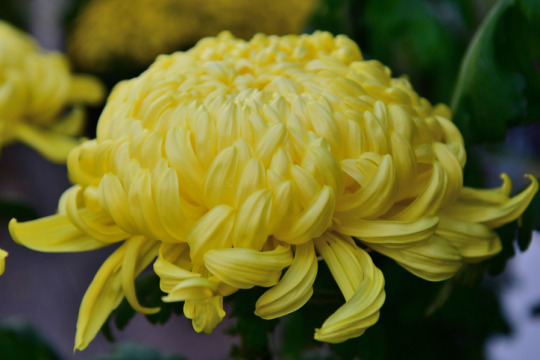
Chrysanthemum. magicflute002/Getty Images
Similar in appearance to a cheerleader’s pom poms, chrysanthemums (Chrysanthemums spp.) are some of the showiest plants found in nature. The blooms come in a variety of colors and forms, with some cultivars displaying single or double layers, while others burst with spherical petals. In the United States, chrysanthemums (or simply mums) are most commonly seen during the cooler, autumn months, decorating porches alongside pumpkins and stalks of corn; however, in the Far East, where they originated, they’re a common emblem and can be seen blooming in gardens in the autumnas well as in traditional paintings. These perennials are particularly revered in Japanese culture. “The chrysanthemum is associated with perfection and nobility,” he says. “The Imperial Seal of Japan is a chrysanthemum. It’s also regarded as one of the four ‘noble species’ alongside plum, orchid and bamboo.”
Amaranth (Peru)
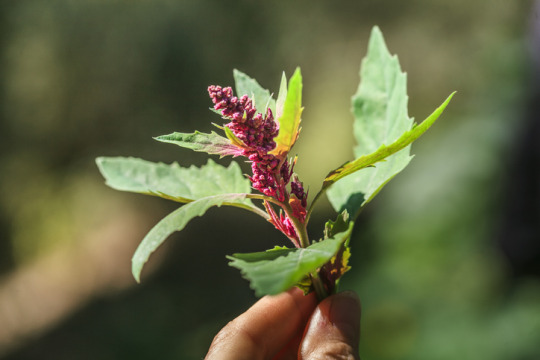
Amaranth. Photo by Enrique Díaz / 7cero/Getty Images
Amaranth falls into the category of forgotten grains, since it’s often overshadowed by more readily available whole grains like oats and rye. However, it has gained popularity in recent years thanks to being highly nutritious and a good source of amino acids. In fact, prior to the Spanish Conquest in 1519, amaranth was a staple foodstuff of the Inca and Aztec empires. The Aztecs used the seeds of the scruffy garnet plant for ceremonial purposes, mixing amaranth flour with agave syrup and molding the mixture into figures representing important deities within their culture, such as Tlaloc, the god of rain. Upon seeing this, Spanish conquistadors banned the crop, believing “the practice to be the work of the devil,” Drori says. In modern-day Peru, a popular street snack called turrones is made by popping the seeds—similar to popcorn—and mixing it with agave syrup or molasses in a nod to the Aztecs.
Blue Agave (Mexico)

Blue agave. Photo by Matt Mawson/Getty Images
Blue agave (Agave tequilana) can be found in parts of the southern United States and Central America, but it’s most frequently grown in a sunny swath of rolling hills in Jalisco, a state in the western portion of Mexico. It’s there, in a town called Tequila, where the world’s top distillers make tequila using the piñas (hearts) found at the center of the spiky blue succulents. While the leaves of the blue agave are covered in barbs and inedible, the flowers of the plant are the source of agave syrup, a clear, sticky liquid similar to honey often used to sweeten up margaritas and other drinks. Once fermented, it turns into pulque, a milky alcoholic drink similar to low-octane beer that was originally used by the Aztecs during religious ceremonies. “Drawings of the goddess of fertility, Mayahuel, can be seen in the Aztec culture depicting the deity as a being with 400 breasts dripping with pulque,” Drori says. Today pulquerias serving the drink can be found in cities across Mexico.
#Around the World in Eight Plants#food#plants#human development#diet#nutrition#human existence#flowers#food and humans
3 notes
·
View notes
Text
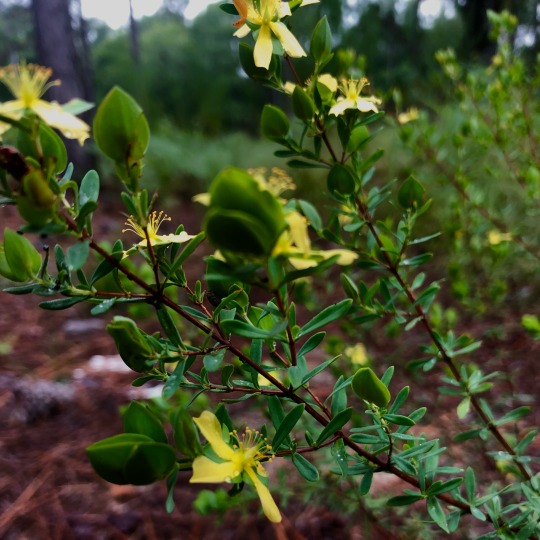
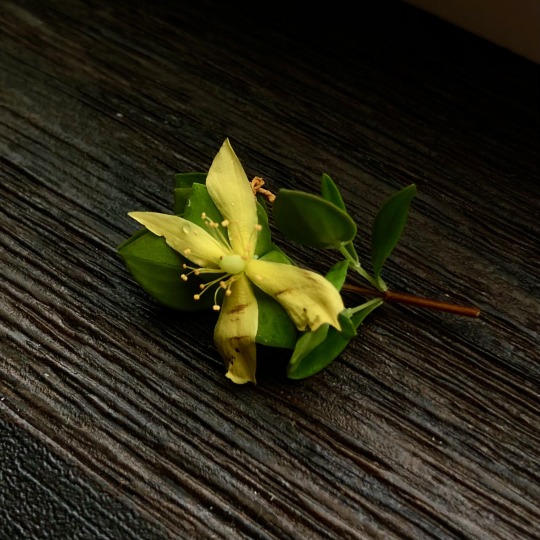
Today’s foraging find: St. Andrews Cross (Hypericum hypericoides)
This lovely herb belongs to the Hypericaceae family, the same as St. John’s Wort; and is native to the southeastern United States, Mexico, Central America, and the Caribbean.
#st. andrews#st andrews cross#herbalist#herbalism#witches of tumblr#witchblr#witchcraft#dark naturalism#green witchcraft#us south east#southeastern united states
6 notes
·
View notes
Photo

The long Labor Day holiday weekend is widely considered to be the unofficial end of summer by many Americans. By early September there are already subtle seasonal changes afoot – an ochre tinge to the sun’s rays, a shortening of days and lengthening of shadows, and a slight autumnal chill hanging in the morning air. Not to mention that Labor Day weekend signals the start of a new school year for many kids, parents, teachers and staff. So why not usher summer out in style with one last “cookout” hurrah? Here are a few ideas to help you make it a 2022 Labor Day commemoration for the books.
Appetizer: Salsa Fresca
A big bowl of fresh, homemade salsa makes a great opening act for any gathering or celebration. There is a tomato bounty available at your local farmers market right now, with tomatoes of all kinds remaining at their peak ripeness for the next several weeks – perfect for using in salsa fresca. The consistency of salsa you desire will largely be determined by the type of tomatoes you use in your recipe. For a thicker, less watery salsa, strain any juicy tomatoes before adding them to the mix. Of course, feel free to scale the amount of onion, cilantro and jalapeno you include to curate for different taste preferences. For something a little different, try making a salsa verde using tomatillos -- small, green husk-covered tomatoes that are native to Mexico and easy to find at farmstalls in September.
Main Course: Shish Kebabs
Instead of flipping the same old burgers and dogs on the grill, elevate your typical Labor Day cookout routine with a shish kebab bonanza! The term shish kebab has an interesting etymological origin as it is an anglicization of the Turkish words ‘şiş’, signifying sword or skewer, and ‘kebap’ meaning ‘roasted meat dish’. A traditional shish kebab is made from skewered and grilled cubes of lamb. However, kebabs offer a wonderful outlet through which to express your creative bbq’ing skills, so there really is no limit to what ingredient combos you can put together. Try alternating cubes of marinated chicken, shrimp, beef or lamb with a variety of summer vegetables including squash, red and yellow bell pepper, tomato, mushroom and onion. Here are a few other pro tips when it comes to skewer grilling:
Use wooden skewers instead of metal to avoid over-cooking the meat.
Soak wooden skewers in water for at least one hour before using them.
Use double skewers to gain better control when turning kebabs over the grill.
Keep some space between the pieces of meat to help them cook more evenly.
Paint the kebabs with the extra marinade as they cook to add more flavor.
Dessert: Grilled Peaches
Don’t extinguish those charcoals just yet! Keep the flames a-lickin’, as grilled peaches make for a delicious, healthy and easy-to-prep dessert. Try to select ripe peaches at the market or ripen them on the kitchen counter before grilling. If possible, choose “freestone” peaches whose pits are easier to remove than the “clingstone” variety. If you’re having difficulty removing the pits, cut the peaches across their middle and twist to separate the two halves. Liberally brush the inside of the peaches with a mix of melted butter, brown sugar or honey, and cinnamon (or any other warm spices such as ginger, nutmeg and cardamom), and grill until tender. You can opt to top the finished product with a scoop of vanilla ice cream or dollop of whipped cream before serving! Nectarines, plums and apricots can also be prepared in the same way.
Beverage: Inventive Cocktails
Move beyond beer and pick up a few bottles of locally produced spirits, fresh produce, condiments and herbs at the farmers market to let your inner mixologist burst forth this Labor Day weekend. Adding attractive garnish to any mixed drink, whether it be alcoholic or not, will always make it taste better simply because it looks more inviting, while adding a soupçon of nutritional value to your beverage of choice. Muddle a handful of fresh mint into your mojito, plop a skewer of stuffed olives, dill pickle spear and crunchy stick of celery into your Bloody Mary, add a sprig of thyme to your whisky sour, or peel some slices of cool cucumber into your gin & tonic. Have fun with it and don’t forget to take pics of your cocktail creations to share.
Cheers to you all while wishing you a delicious, relaxing and safe Labor Day weekend!
#LaborDay2022#laborday#Labor Day 2022#cookout#shishkebab#salsa fresca#grilled peaches#inventive cocktails#downtoearthmkts
2 notes
·
View notes
Text
Tamarindus indica: A Versatile Tropical Fruit in Global Cuisine
Tamarindus indica, commonly known as tamarind, stands as a testament to nature's culinary bounty, offering a unique blend of flavors and textures cherished across continents. From the bustling streets of Bangkok to the vibrant markets of Mexico City, tamarind's presence in global cuisine is unmistakable, enriching dishes with its distinctive tangy sweetness.
Native to tropical regions such as Africa, India, and parts of Southeast Asia, tamarind has traversed borders and found its way into kitchens worldwide. Its journey from tree to table begins with the green, sour pulp of the young fruit, evolving into a luscious paste as it ripens, balancing its sour notes with a delightful hint of sweetness.
One of the most intriguing aspects of tamarind is its versatility in culinary applications. In Indian cuisine, it lends its tangy flavor to chutneys, sauces, and curries, adding depth and complexity to beloved dishes like samosas and rasam. Across Southeast Asia, tamarind is a staple ingredient in savory soups, stir-fries, and marinades, enhancing the taste of dishes such as Pad Thai and Massaman curry.
Beyond its role in savory fare, tamarind shines in the realm of sweets and refreshments. In Mexico, agua de tamarindo, a refreshing drink made from tamarind pulp, sugar, and water, offers respite from the heat with its tangy, thirst-quenching goodness. Similarly, in the Middle East, tamarind finds its way into desserts like sharbat, a sweet syrup infused with spices and herbs, offering a delightful blend of flavors to tantalize the taste buds.
Apart from its culinary allure, tamarind boasts a rich nutritional profile, making it not just a flavorful addition to dishes but also a healthful one. It is a potent source of magnesium, essential for maintaining bone health, and contains significant amounts of calcium, crucial for bone strength and density. Incorporating tamarind into one's diet, alongside weight-bearing exercise, may contribute to osteoporosis prevention and overall bone health.
For more information visit us:
#tamarind#tamarind powder#Tropical fruit#Tamarindus indica#Culinary uses#Sour pulp#Sweet-sour flavor#Date of India#Magnesium-rich
0 notes
Text
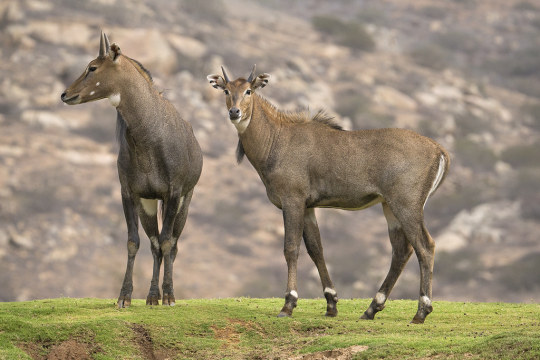




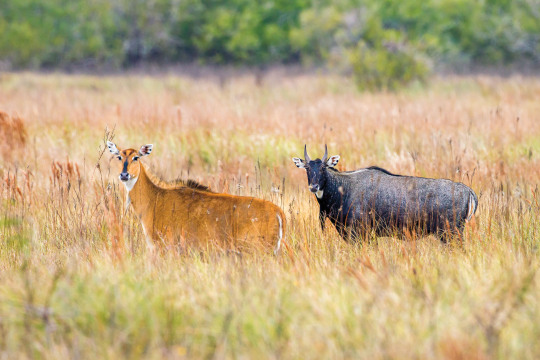








Boselaphus tragocamelus bette known as the nilgai, blue bull, or white-footed antelope, is a species of antelope endemic to the grasslands, scrublands, dry forests, and agricultural lands of India, Pakistan, and Nepal. Additionally they were introduced to the US state of Texas by big game hunters in the 1930s and have since become a feral and invasive species throughout Texas, Alabama, Florida and Mississippi and the Mexican state of Tamaulipas. They are diurnal and moderately social animals typically living in groups of less than 10 individuals, tho congregations of up to 70 are not unheard of, particularly during the breeding season. Three distinct types of herds are formed: females with young calves, adult and juvenile females, and all males. Nilgai are mixed feeders, eating a variety of grasses, shrubs, leaves, seeds, flowers, fruit, herbs, vines, and woody plants. Nilgai don’t often drink water getting the majority of there moisture from there diet. Nilagai are preyed upon by wolves, striped hyenas, leopards, dholes, coyotes, mountain lions, Asiatic lions, alligators, crocodiles, and tigers. Reaching 3.3 to 5ft (1 to 1.5m) tall at the shoulder, 5.7 to 7ft (1.7 to 2.1m) in length, and 220 to 640lbs (100 to 290kgs) in weight, Nilgai are the largest antelope in asia. They are characterized by there sturdy bodies, thin-legs, sloping back, a deep neck with a white patch on the throat, a short crest of hair along the neck terminating in a tuft, a dewlap, and white facial spots. Sexual dimorphism is prominent with males being considerably larger than females, and while females and juveniles are orange to tawny, adult males have a bluish-grey coat. Additionally only males have horns. Mating may occur throughout the year, but peaks during the breeding season which is October to February in there native range and December to March in the USA and Mexico. During such time male and female herds join up with one another and males become aggressive and fight among themselves for dominance. After an 8 to 9 month pregnancy a mother nilgai will give birth to 1 to 3 calves. They young remain with there mothers before setting off to join a different herd at around 10 months, under ideal conditions a nilgai may live up to 21 years.
#pleistocene pride#pleistocene#pliestocene pride#pliestocene#cenozoic#ice age#stone age#mammal#antelope#nilgai#blue bull
1 note
·
View note
Text
Buy Herbal Incense Blends Online - mysteriousplant.com
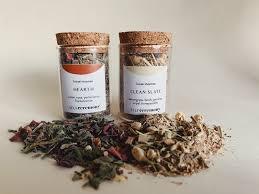
Herbal incense blends, also known as "herbal smoking blends" or "legal herbal highs," are mixtures of various dried herbs and botanicals that are often smoked or vaporized for their aromatic and relaxing properties. These blends can vary widely in composition and effects, and they are often marketed as alternatives to traditional tobacco or cannabis products. It's important to note that while these blends are typically marketed as natural or herbal alternatives, they may still carry health risks, and their sale and use may be subject to legal restrictions in some jurisdictions.
Here are some common herbs and botanicals that are often used in herbal incense blends:
Damiana: Damiana is a small shrub native to Mexico, Central America, and the southern United States. It has a long history of use as an aphrodisiac and relaxant and is often included in herbal smoking blends for its mild psychoactive effects.
Mullein: Mullein is a flowering plant that is native to Europe, Asia, and North Africa but has been naturalized in many other regions. It has a long history of use in traditional herbal medicine and is often included in herbal smoking blends for its soothing properties.
Mint: Various types of mint, such as peppermint and spearmint, are often included in herbal incense blends for their refreshing aroma and flavor. Mint is also believed to have calming and digestive properties.
Lavender: Lavender is a fragrant herb native to the Mediterranean region. It is widely used in aromatherapy for its calming and relaxing effects and is often included in herbal incense blends for its pleasant aroma.
Passionflower: Passionflower is a vine native to the southeastern United States, Central America, and South America. It has a long history of use in traditional herbal medicine for its sedative and anxiolytic properties and is often included in herbal smoking blends for its calming effects.
Blue Lotus: The blue lotus is a water lily native to Egypt. It has a long history of use in ancient Egyptian and Indian cultures for its psychoactive properties, and it is often included in herbal incense blends for its euphoric and mildly hallucinogenic effects.
Marshmallow Leaf: Marshmallow leaf comes from the marshmallow plant (Althaea officinalis) and is often included in herbal smoking blends for its smooth smoke and mild flavor.
Raspberry Leaf: Raspberry leaf is often included in herbal incense blends for its mild flavor and potential health benefits, including its high vitamin and mineral content.
It's essential to approach the use of herbal incense blends with caution and to research the specific herbs and botanicals included in any blend you're considering using. Some herbs may interact with medications or have adverse effects on certain individuals, and smoking any substance carries inherent health risks. Additionally, the legality of herbal incense blends can vary depending on your location, so it's essential to familiarize yourself with the laws and regulations in your area.
Email: [email protected]
#mysteriousplant.com#Herbal Incense Blends#buy Herbal Incense Blends#sale Herbal Incense Blends#order Herbal Incense Blends#online Herbal Incense Blends
0 notes